The Netherlands is home to a wide variety of bird species, making it a paradise for bird lovers. From the great cormorants and purple herons of the coastal wetlands to the lapwings and black-tailed godwits of the polders and meadows, there is something for every type of bird watcher.
The country is also home to a number of rare and endangered bird species, including the Eurasian spoonbill, the black-necked grebe, and the red-footed falcon. With its varied landscapes and habitats, the Netherlands is an ideal place to spot a variety of birds.
1. Barn Owl
Barn owls are a beautiful and fascinating species of birds found around the world, with the exception of polar and desert regions, most of Indonesia and some Pacific Islands.
They have large eyes, thin legs and long wings that help them to hunt silently in low light conditions.
Their white colouring helps them blend into their surroundings making it easier for them to catch prey.
Barn owls are nocturnal hunters who use their impressive hearing capabilities to locate rodents moving within vegetation or tunnels beneath the ground.
They also feed on insects such as beetles, moths etc., which they can detect from high up in flight using their excellent vision even at night time.
The barn owl plays an important role in balancing ecosystems by controlling rodent populations which is why they should be protected wherever possible so that this vital service continues uninterruptedly.
Scientific classification:
| Kingdom | Animalia |
| Phylum | Chordata |
| Class | Aves |
| Order | Strigiformes |
| Family | Tytonidae |
| Genus | Tyto |
| Species | T. alba |
2. Crow Family
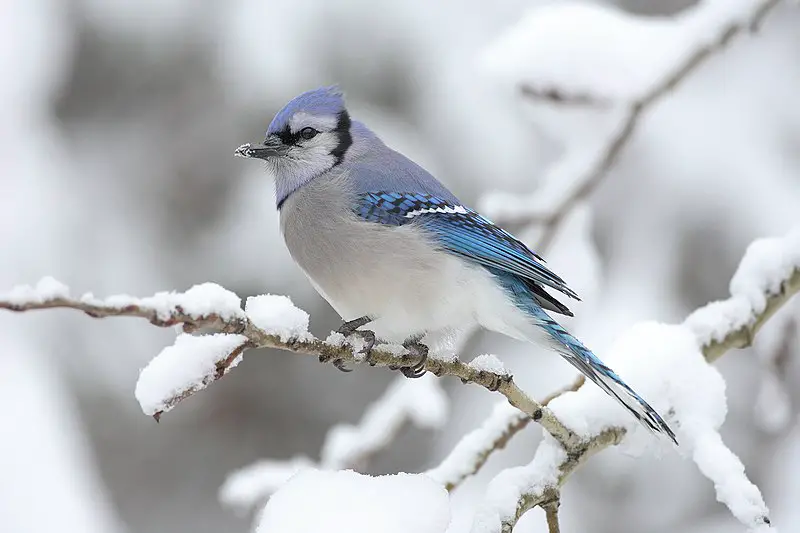
The Crow family is a cosmopolitan group of birds that contains crows, ravens, rooks, jackdaws, jays, magpies and more.
Altogether there are 133 members in this bird family which all share similar characteristics such as large beaks and feet.
The genus Corvus alone makes up over a third of the entire crow family population with species like the common crow or blackbird being some of its most recognizable members.
All these birds have strong social bonds so they often travel in groups to find food sources or build nests together for protection against predators.
With their intelligence and adaptation skills they are able to survive almost anywhere on Earth from mountains to cities making them one of the world’s most successful families of avian creatures .
Scientific classification:
| Kingdom | Animalia |
| Phylum | Chordata |
| Class | Aves |
| Order | Passeriformes |
| Superfamily | Corvoidea |
| Family | Corvidae Leach, 1820 |
3. Eurasian Teal
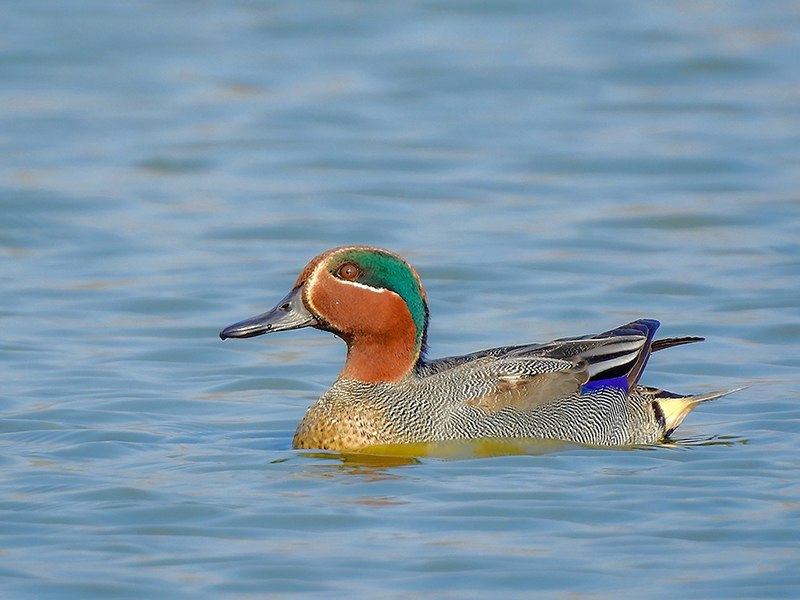
The Eurasian teal, also known as the common teal or the Eurasian green-winged teal, is a small dabbling duck that inhabits temperate Europe and Asia.
It has an unmistakable blue-green colouring which gives it its name.
During winter months they migrate south in large flocks to areas with warmer climates where there is more food available for them to feed on.
The Eurasian Teals are highly social birds; they often congregate in groups of hundreds or even thousands during migration periods.
They mostly feed on aquatic vegetation such as grasses and weeds but will occasionally hunt insects too.
These ducks make beautiful sights when flying over lakes or streams, their wings producing a distinctive whistling sound while they glide across the sky.
Scientific classification:
| Kingdom | Animalia |
| Phylum | Chordata |
| Class | Aves |
| Order | Anseriformes |
| Family | Anatidae |
| Genus | Anas |
| Species | A. crecca |
4. Eurasian Collared Dove
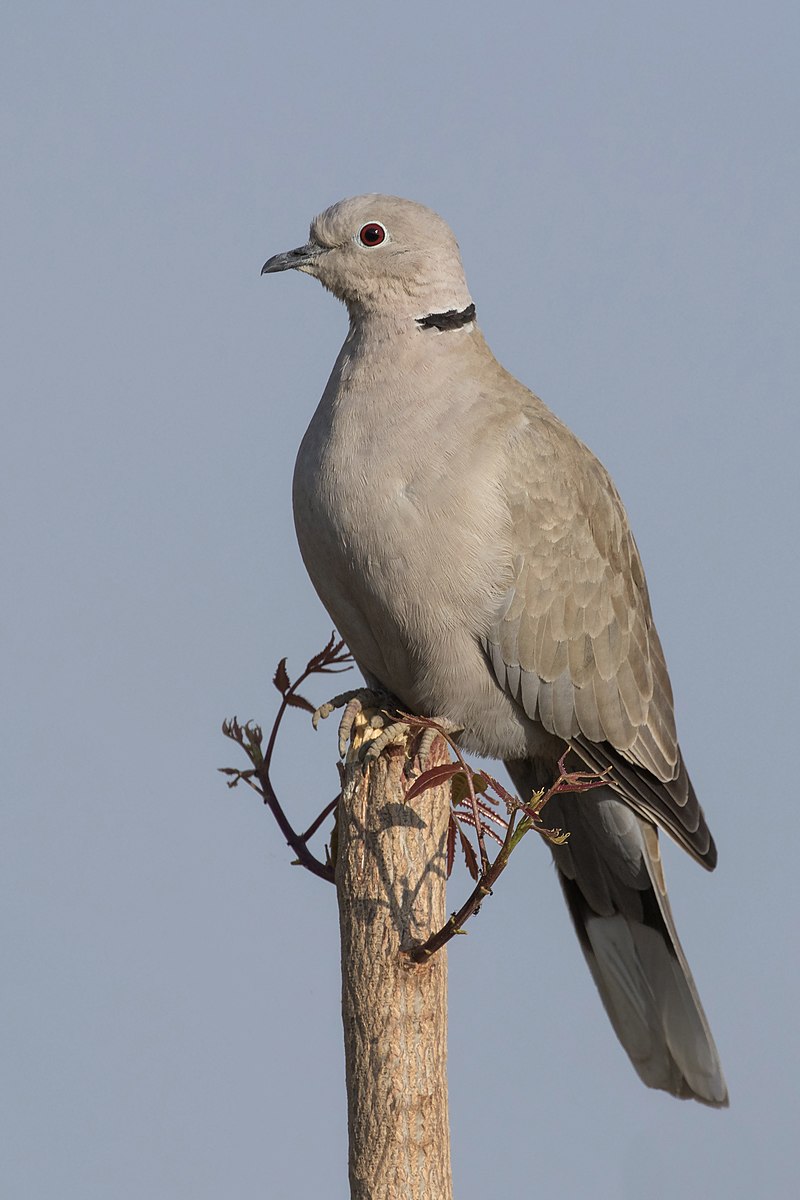
The Eurasian collared dove is a species of bird native to Europe and Asia, with its range expanding through introduction in Japan, North America, and islands in the Caribbean.
It has become so widespread that it is listed as Least Concern on the IUCN Red List. The scientific name for this bird was proposed by Hungarian naturalist Imre Frivaldsz – Columba decaocto.
This beautiful creature typically measures between 33-37 cm from tip to tail feathers, displaying an overall greyish brown plumage; they also have distinctive black half collar around their neck which gives them their common name.
These birds are mainly found inhabiting open woodlands or agricultural lands near human settlements where there’s plenty of food available such as grain fields or gardens where fruits can be eaten off trees.
With a vast global population trend increasing steadily each year these birds make great additions to many backyards throughout the world.
Scientific classification:
| Kingdom | Animalia |
| Phylum | Chordata |
| Class | Aves |
| Order | Columbiformes |
| Family | Columbidae |
| Genus | Streptopelia |
| Species | S. decaocto |
5. Herons
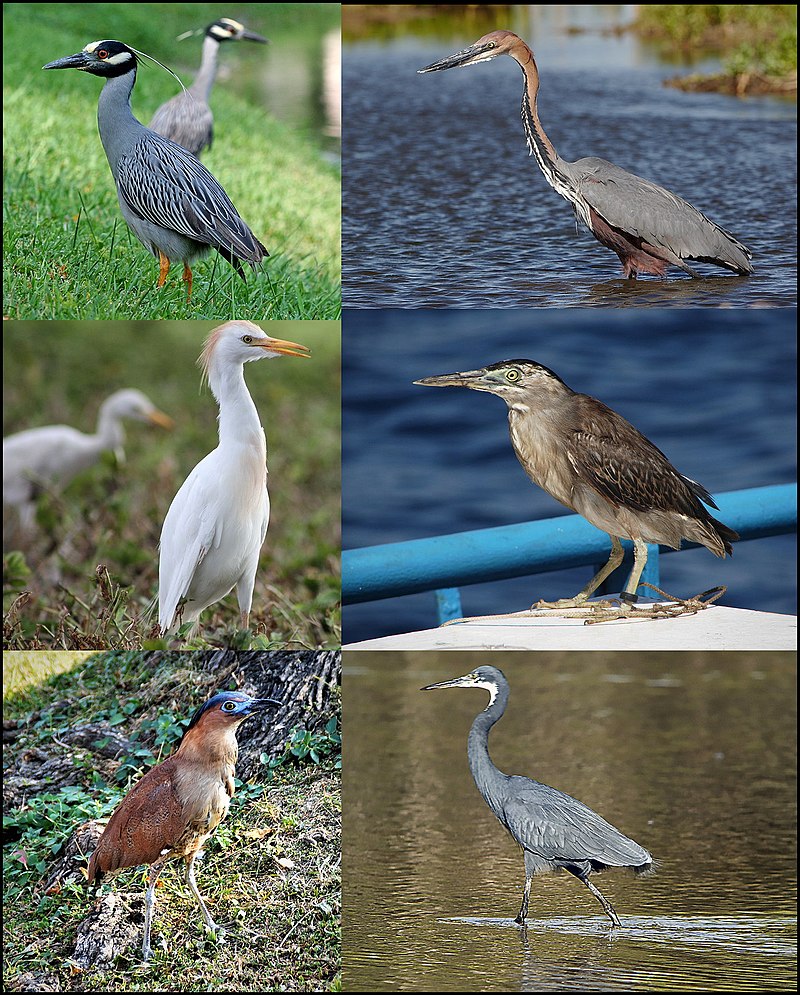
Herons are graceful and elegant birds belonging to the family Ardeidae, with 72 distinct species.
They have long legs and necks that are well-adapted for wading in shallow water like streams or ponds.
Herons can be found near freshwaters as well as along coastal areas worldwide.
Some of these species may also be referred to as egrets, bitterns or zigzag heron/bittern because they belong to certain genera such as Botaurus and Ixobrychus respectively.
These birds stand tall when searching for food by standing still in a shallow body of water while waiting patiently until prey appears before quickly capturing it with their sharp bills.
Scientific classification:
| Kingdom | Animalia |
| Phylum | Chordata |
| Class | Aves |
| Order | Pelecaniformes |
| Suborder | Ardei |
| Family | Ardeidae Leach, 1820 |
6. European Green Woodpecker
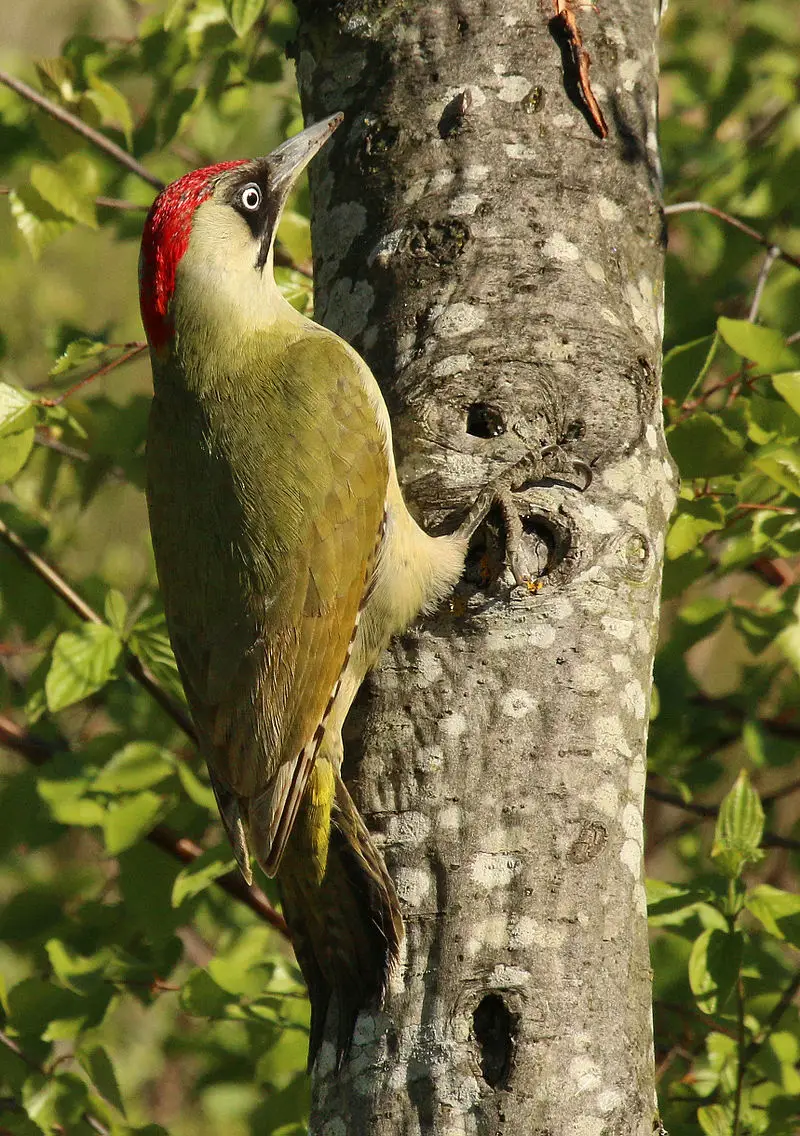
The European green woodpecker is a vibrant species with striking features. The body has an emerald hue, while males have a red crown and black moustache that extends to the middle of their forehead.
Females lack this characteristic feature but instead possess barred markings beneath the wings as well as yellow throats and cheeks.
It can be found in many parts of Europe and western Palearctic regions such as Spain and Portugal where it is replaced by its similar cousin; Iberian green woodpecker (Picus sharpei).
This bird loves inhabiting open forests or grasslands for its food source which typically consists on insects like ants, beetles, spiders among others.
Its powerful bill allows it to dig into tree bark searching for larvae underneath making it an efficient predator in these environments.
Scientific classification:
| Kingdom | Animalia |
| Phylum | Chordata |
| Class | Aves |
| Order | Piciformes |
| Family | Picidae |
| Genus | Picus |
| Species | P. viridis |
7. Black-Tailed Godwit
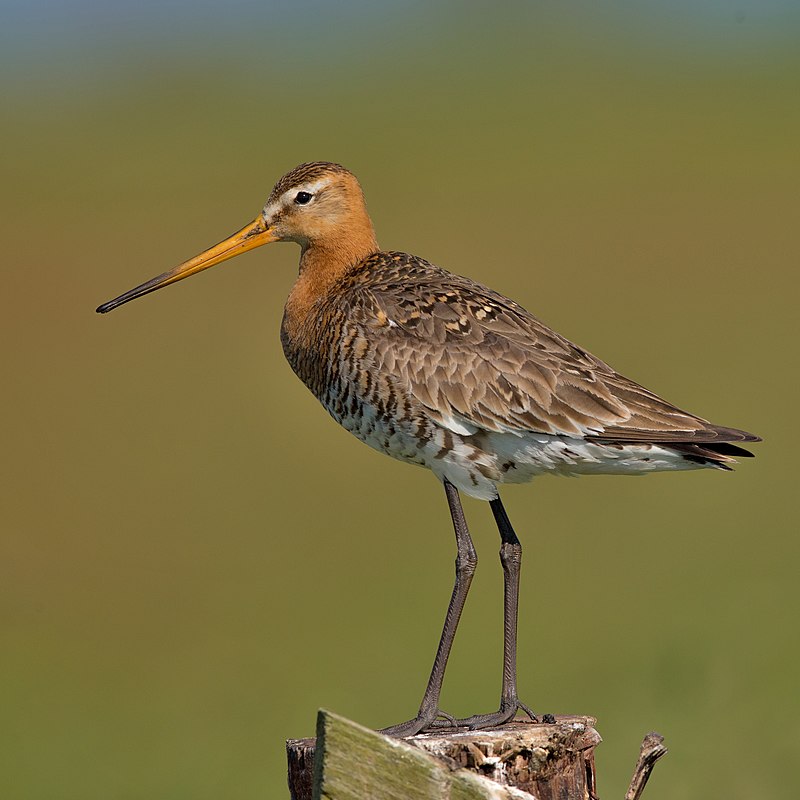
The Black-tailed Godwit is a species of large shorebird that was first described by Carl Linnaeus in 1758.
These beautiful birds have an orange head, neck and chest during breeding season while they turn to grey-brown coloration in winter.
They are easily identifiable due their black and white wingbar throughout the year. As for its habitat, these godwits breed mostly on Iceland but also across Europe, eastward through Asia Minor all the way to Mongolia; some even winter further south in Africa or India.
The Godwit has adapted well to human presence as it can be found close to wetlands near farms or villages where plenty of food is available from ploughed fields.
It’s really amazing how such a majestic bird with colorful plumage manages so successfully at this day and age.
Scientific classification:
| Kingdom | Animalia |
| Phylum | Chordata |
| Class | Aves |
| Order | Charadriiformes |
| Family | Scolopacidae |
| Genus | Limosa |
| Species | L. limosa |
8. Eurasian Coot
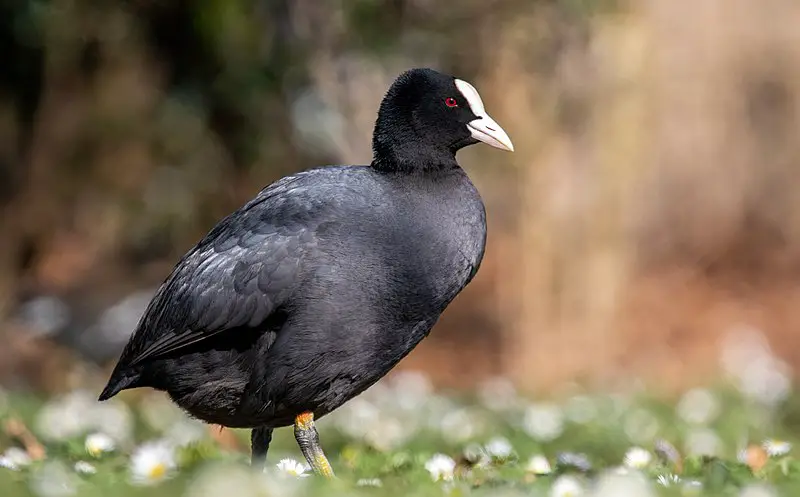
The Eurasian Coot is a water bird belonging to the Rallidae family. It has an overall slaty-black body with a glossy black head and white bill, along with a white frontal shield.
Both male and female coots look similar in appearance. This species can be found across Europe, Asia, Australia, New Zealand and parts of North Africa – making it quite widespread.
In terms of behavior they usually feed on aquatic plants as well as insects while swimming or walking on land near bodies of water such as ponds or lakes.
They are also known for their aggressive nature when defending nesting sites from other birds during breeding season.
Scientific classification:
| Kingdom | Animalia |
| Phylum | Chordata |
| Class | Aves |
| Order | Gruiformes |
| Family | Rallidae |
| Genus | Fulica |
| Species | F. atra |
9. Great Spotted Woodpecker
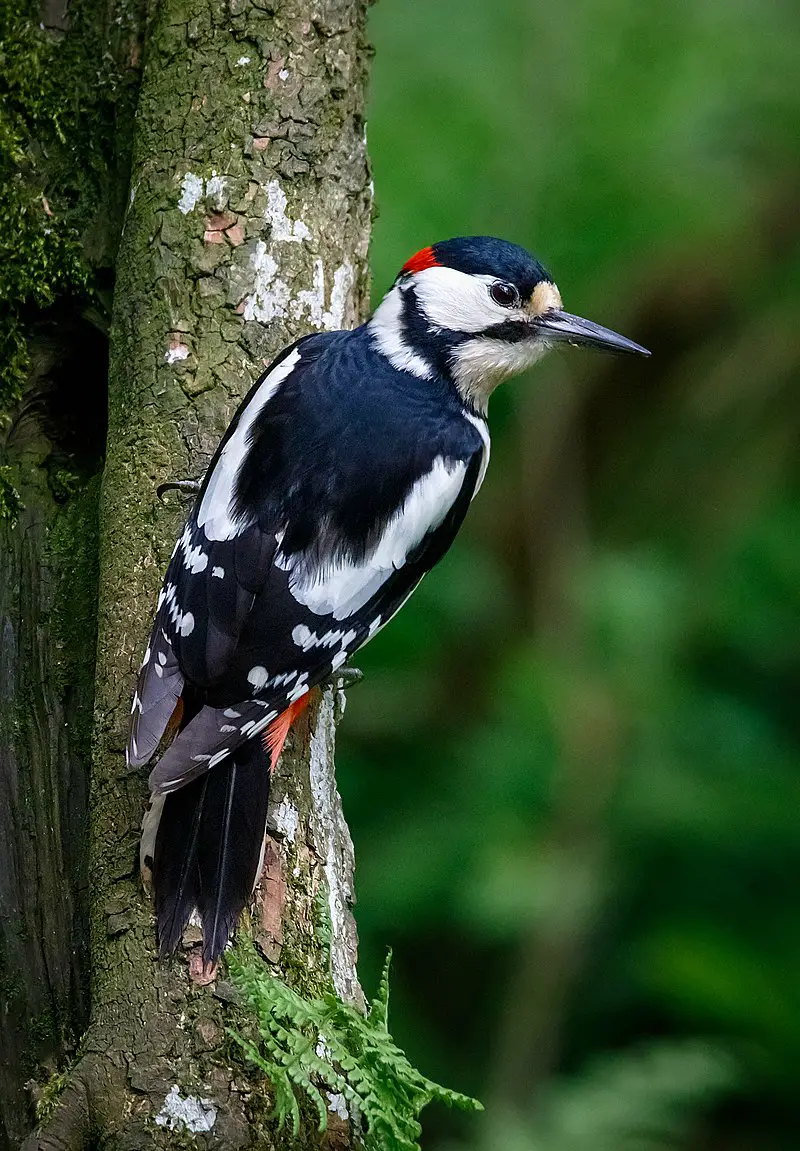
The Great Spotted Woodpecker is a fascinating bird. It has black and white feathers, with red patches on its lower belly and head or neck depending on whether it’s male or young.
This species inhabits most of the Palearctic region as well as some parts of North Africa.
For much of its range, it remains in one place all year round but may migrate if food sources become limited further north.
Its diet consists mainly of insects found under tree bark along with small amounts of seeds and fruit when available.
Despite being quite vocal they are hard to spot due to their camouflaged feathers which helps protect them from predators like cats and birds-of-prey.
Scientific classification:
| Kingdom | Animalia |
| Phylum | Chordata |
| Class | Aves |
| Order | Piciformes |
| Family | Picidae |
| Genus | Dendrocopos |
| Species | D. major |
10. Crows
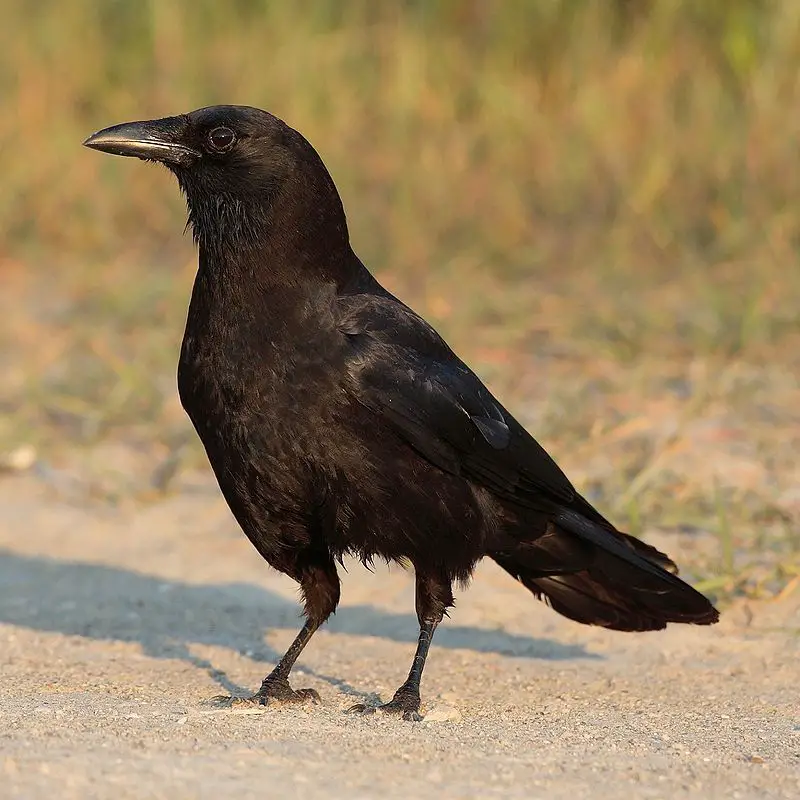
Crows are medium to large birds with a wide range of species belonging to the Corvidae family. They can be found in Europe, Asia, America and Australia.
Common crows include carrion crow, hooded crow, common raven and rooks which differ mainly by size; crows being generally smaller than their counterparts.
Crows have distinctive black feathers that contrast against their white eyes while they possess an intelligence far beyond other birds as they will use tools for tasks like cracking open nuts or making nests out of twigs.
Their curious nature makes them great problem-solvers when faced with challenging situations such as finding food sources or navigating new terrain.
Scientific classification:
| Kingdom | Animalia |
| Phylum | Chordata |
| Class | Aves |
| Order | Passeriformes |
| Family | Corvidae |
| Subfamily | Corvinae |
| Genus | Corvus Linnaeus, 1758 |
Also Featured In: Most Common Nature Birds, Birds of Symbolism
11. Eurasian Blue Tit
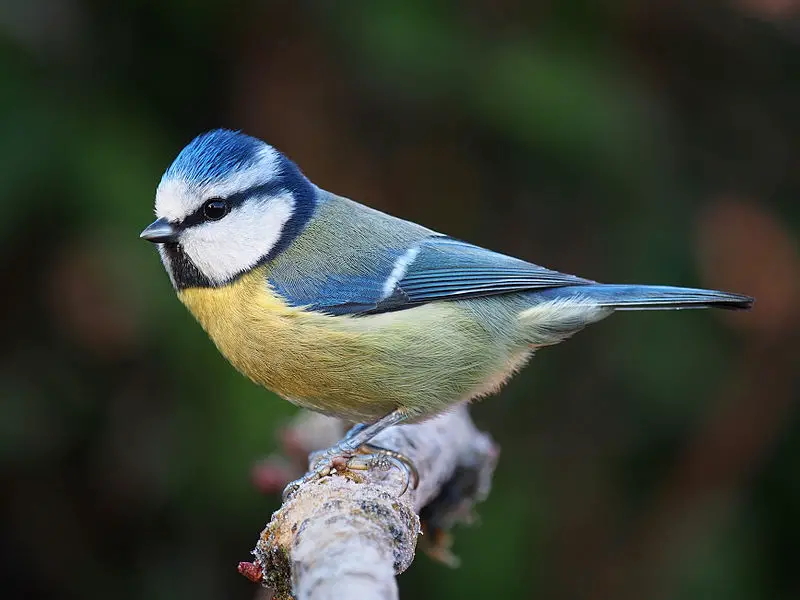
The Eurasian blue tit is a small passerine bird belonging to the Paridae family. Its bright blue and yellow plumage makes it easily recognizable, along with its small size.
They are usually resident birds that do not migrate, living throughout temperate or subarctic Europe and western Palearctic in deciduous woodlands.
These birds breed year-round and are common residents of these areas.
Their diet consists mainly of insects but they also feed on seeds during winter months when insects become scarce.
They can be found both alone or in pairs searching for food amongst trees branches, shrubs, grasses as well as visiting gardens for supplementary food sources such as peanut feeders provided by garden owners.
Scientific classification:
| Kingdom | Animalia |
| Phylum | Chordata |
| Class | Aves |
| Order | Passeriformes |
| Family | Paridae |
| Genus | Cyanistes |
| Species | C. caeruleus |
12. Ruff
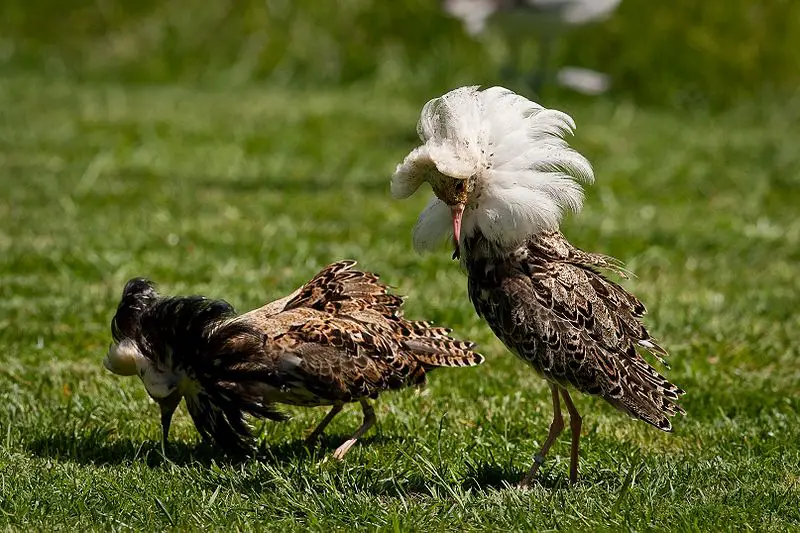
The Ruff is a medium-sized wading bird found in wetlands across northern Eurasia. It has an unmistakable appearance, with its long neck and pot belly body combined with bright plumage of males contrasting the duller browns of females.
During breeding season, males have unique feathers that form a ruff around their head which gave them their name.
This species displays sexual dimorphism; male Ruffs are much more colourful than female counterparts and they also develop longer bills during mating season to show off to potential mates.
Migratory by nature, huge flocks can be seen on winter grounds like Europe, Africa, Asia and Australia before returning back north for summer months when food sources become abundant again.
Scientific classification:
| Kingdom | Animalia |
| Phylum | Chordata |
| Class | Aves |
| Order | Charadriiformes |
| Family | Scolopacidae |
| Genus | Calidris |
| Species | C. pugnax |
Also Featured In: Belarus Birds You Should Know, Large African Birds You Need to Know
13. Common Tern
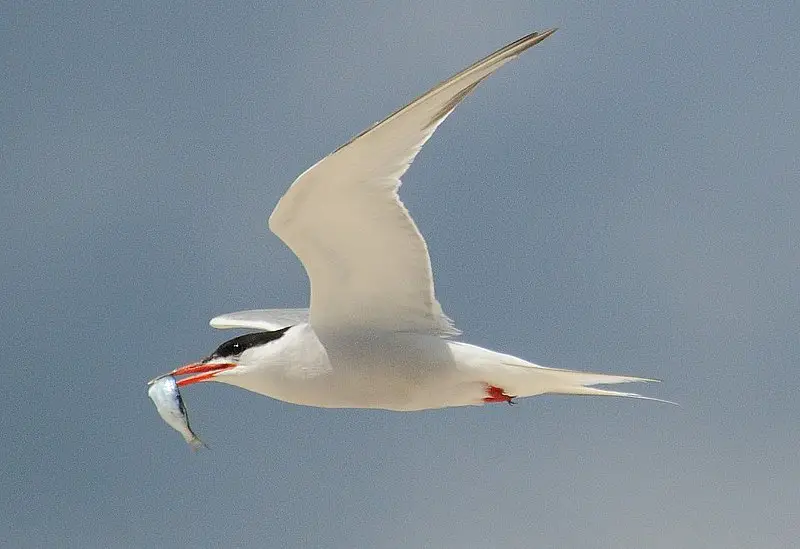
The Common Tern is a seabird in the Laridae family, found all over Europe, Asia and North America. It has a migratory nature, spending its winters in coastal tropical and subtropical regions.
Breeding adults have light grey upperparts with white to very light grey underparts featuring an orange-red beak and black cap.
They are known for their graceful flight as they hunt small fish or insects by diving into water from great heights.
During breeding season they build nests together on islands or sandbars using grasses and other materials to create them.
The female will lay two eggs which she incubates while her mate stands guard nearby; both parents take turns feeding the chicks until it’s time for them fly away.
Scientific classification:
| Kingdom | Animalia |
| Phylum | Chordata |
| Class | Aves |
| Order | Charadriiformes |
| Family | Laridae |
| Genus | Sterna |
| Species | S. hirundo |
Also Featured In: Flight Birds You Should Know, Most Common Birds of Sardinia
14. Eurasian Reed Warbler
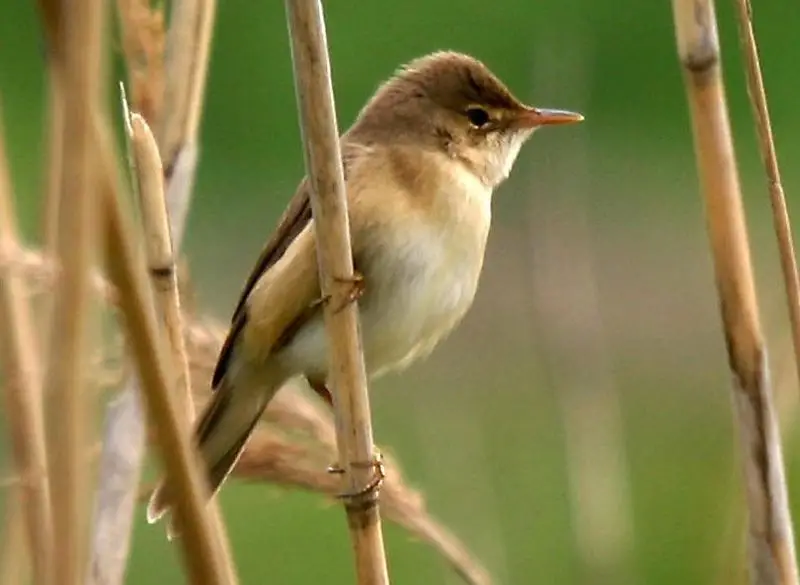
The Eurasian reed warbler (Acrocephalus scirpaceus) is a species of Old World Warbler native to the temperate parts of Europe and Asia.
It breeds in wetlands such as marshes, ponds and rivers with dense vegetation like reeds or tall grasses.
During its wintering season, it migrates southward to sub-Saharan Africa where there are milder conditions.
This small bird has streaked brown plumage on the upperparts and white underparts which makes it difficult for predators to spot among the foliage.
Its diet consists mainly of insects including aphids, caterpillars larvae and moths caught while flying over water or by gleaning from plants growing near water bodies.
The male sings an attractive song consisting of several phrases repeated one after another as part of their courtship display during breeding season in order attract females for mating purposes.
Scientific classification:
| Kingdom | Animalia |
| Phylum | Chordata |
| Class | Aves |
| Order | Passeriformes |
| Family | Acrocephalidae |
| Genus | Acrocephalus |
| Species | A. scirpaceus |
15. Stork
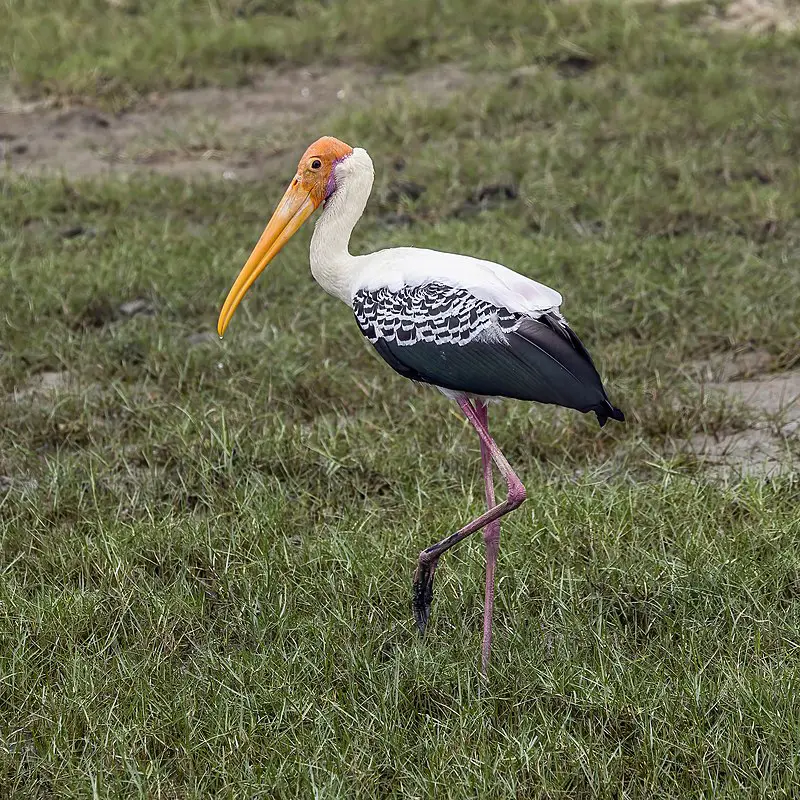
Storks are majestic birds, easily recognizable with their long necks and legs. They belong to the family Ciconiidae, making up the order Ciconiiformes.
Storks inhabit many areas around the world but generally prefer drier habitats than other wading birds like herons or ibises which have been moved to separate orders.
Despite being large in size they can be quite graceful in flight as well as when hunting for food such as insects, small mammals and reptiles near shallow waters.
During nesting season stork pairs build nests on high trees or platforms made of sticks and twigs where they lay eggs that hatch after about a month of incubation time by both parents taking turns sitting on them warmly until hatching day.
Scientific classification:
| Kingdom | Animalia |
| Phylum | Chordata |
| Class | Aves |
| Clade | Aequornithes |
| Order | Ciconiiformes Bonaparte, 1854[1] |
| Family | Ciconiidae J. E. Gray, 1840[1] |
16. Skuas
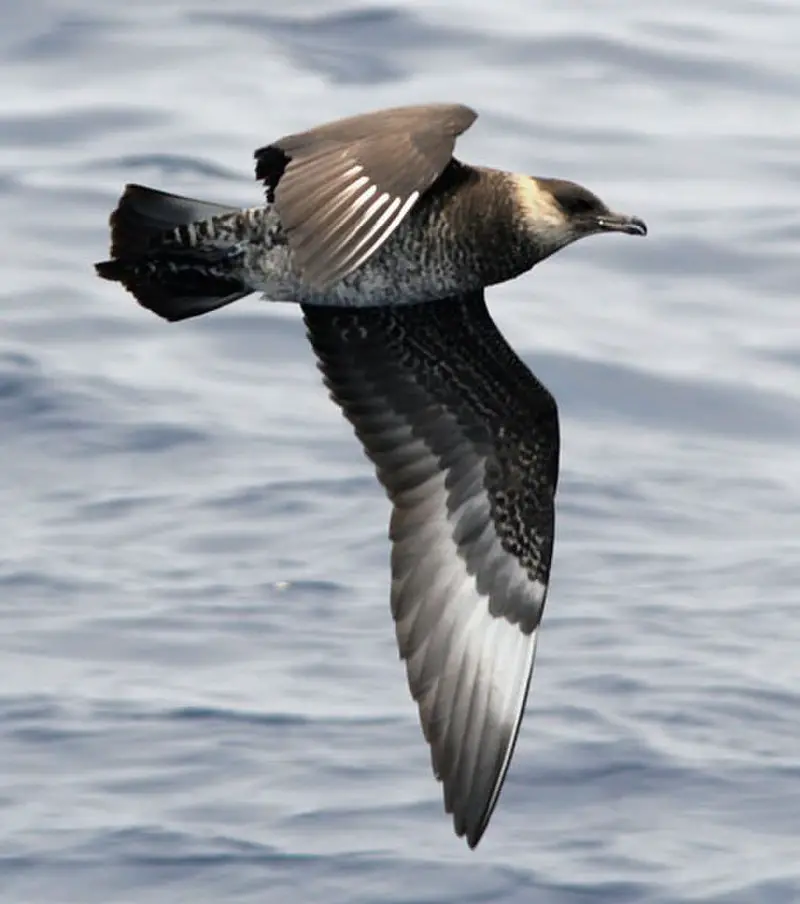
Skuas are a group of predatory seabirds with seven species, all belonging to the genus Stercorarius.
They are also known as “Jaegers” in North America and their name originates from the Faroese word for Great Skua – skúgvur.
These birds typically inhabit coastal areas or open oceans where they feed on fish, krill and other marine creatures.
Skuas can be distinguished by their pointed wings which help them fly long distances while hunting food.
Their distinctive colouration varies depending on age and habitat but generally includes greyish brown upperparts and white underparts with black streaks along its belly area.
The overall size ranges from 24-40 cm making these one of the larger sea bird species.
Scientific classification:
| Kingdom | Animalia |
| Phylum | Chordata |
| Class | Aves |
| Order | Charadriiformes |
| Suborder | Lari |
| Family | Stercorariidae Gray, 1871 |
| Genus | Stercorarius Brisson, 1760 |
17. Bar-Tailed Godwit
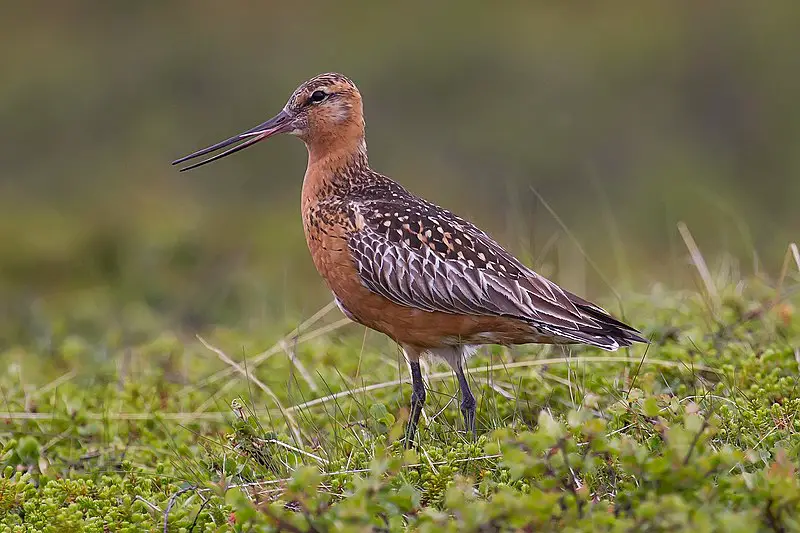
The bar-tailed godwit is a remarkable bird, both in its appearance and behavior. Its striking red breeding plumage stands out amongst the typical browns of other waders.
Long legs help it traverse coastal mudflats and estuaries where it forages on bristle-worms and shellfish.
It has an upturned bill that gives it further distinction from other shorebirds.
Bar-tailed godwits breed on Arctic coasts stretching all the way to Alaska during summer months before migrating south towards warmer temperate or tropical regions for wintering each year – quite incredible.
Despite their long migratory journeys they are still considered a common species due to large numbers making these arduous trips annually, although some populations have experienced declines recently.
Scientific classification:
| Kingdom | Animalia |
| Phylum | Chordata |
| Class | Aves |
| Order | Charadriiformes |
| Family | Scolopacidae |
| Genus | Limosa |
| Species | L. lapponica |
18. Grebes
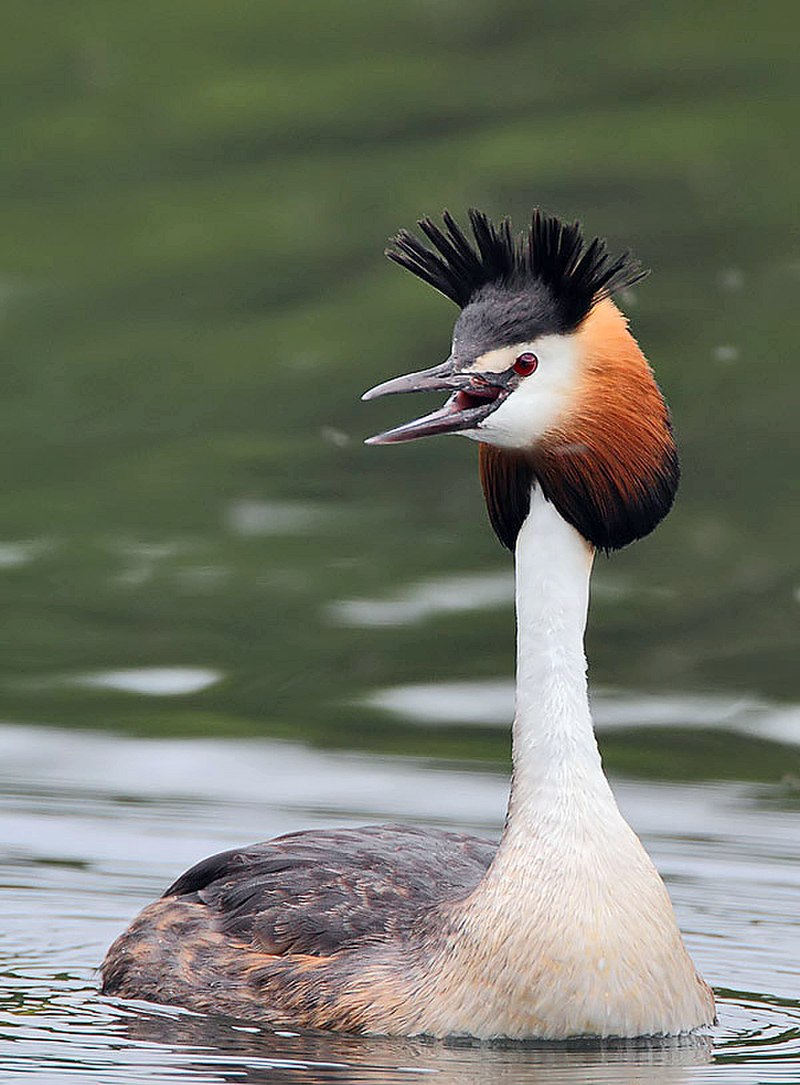
Grebes are a type of diving bird found in freshwater habitats around the world. They belong to the order Podicipediformes and have 22 species that exist across six genera.
Some species can also be found in marine environments during their migration or winter season, and some even live flightless lives on stable lakes.
Grebes vary greatly between regions; for example, they range from 4-32 inches long with anywhere from 8-30 ounces of weight depending on which species it is.
Their plumage may be black, browns/grays or whites but usually consist of bright colors such as yellows, blues and greens while underwater they use these feathers to help them streamline through the water quickly.
Scientific classification:
| Kingdom | Animalia |
| Phylum | Chordata |
| Class | Aves |
| Clade | Neoaves |
| Clade | Mirandornithes |
| Order | Podicipediformes Fürbringer, 1888 |
| Family | Podicipedidae Bonaparte, 1831 |
19. Great Tit
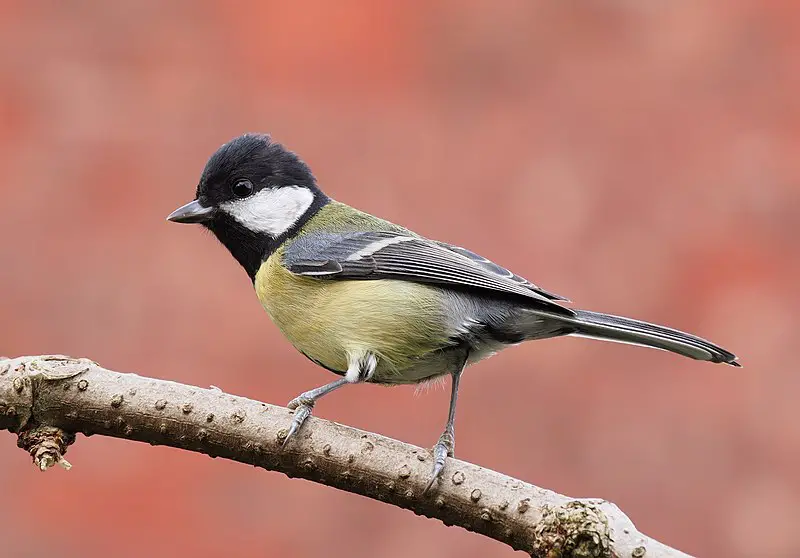
The Great Tit is a small passerine bird found in woodlands throughout Europe, the Middle East and Central Asia. Its beautiful black and white plumage with bold yellow or green patches make it easily distinguishable from other species of its family.
It generally does not migrate except for harsh winters but will stay resident in any kind of woodland area.
The diet consists mainly on insects, seeds and nuts which are found by searching through trees or scavenging from feeders placed near gardens.
Great Tits are also known to be clever problem solvers; they can open milk bottles left out unattended as well as cracking sunflower seeds that provide them essential nutrients during winter months when food is scarce.
Scientific classification:
| Kingdom | Animalia |
| Phylum | Chordata |
| Class | Aves |
| Order | Passeriformes |
| Family | Paridae |
| Genus | Parus |
| Species | P. major |
20. White Stork
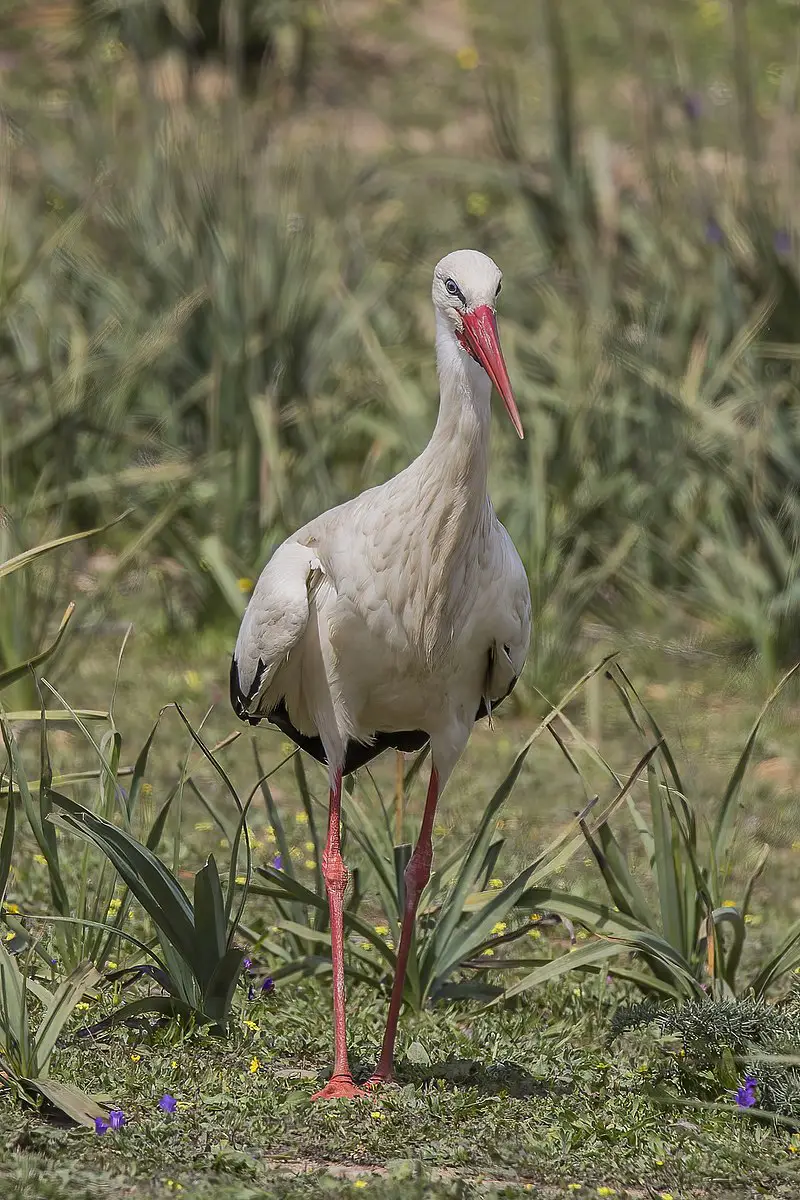
The White Stork is a majestic bird found in Europe, with white plumage and black wings. It has long slender legs and beaks that are usually bright red in color.
The average adult stands around 100 – 115 cm tall from beak to tail tip, while its wing span can reach up to 155-215 cm wide. There are two subspecies of the White Stork which differ slightly by size.
They feed on small animals such as frogs, fish or insects and nest near human dwellings due to the abundance of food available there; they also build nests atop chimneys or roofs when given the chance.
These birds have been revered for centuries as symbols of fertility because their return each spring often coincides with an increase in births among humans living nearby – something superstitious people take great note of.
Scientific classification:
| Kingdom | Animalia |
| Phylum | Chordata |
| Class | Aves |
| Order | Ciconiiformes |
| Family | Ciconiidae |
| Genus | Ciconia |
| Species | C. ciconia |
21. Common Redshank
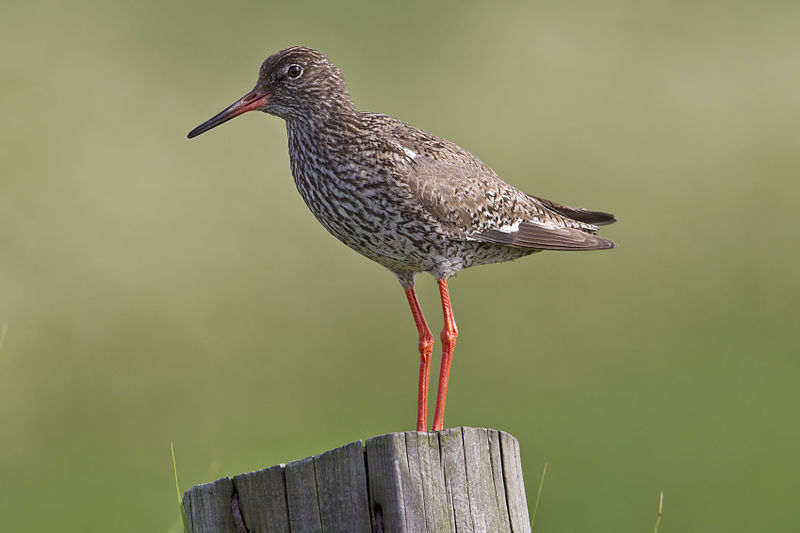
The Common Redshank is a wading bird found in Eurasia. It has long, red legs and dark grey wings. The body of the bird is brownish-grey with white patches on its sides and back.
Its bill is pointed and yellow to orange in colour, while its eyes are black or dark brown.
During migration they can be seen around coasts, estuaries and marshes where they feed mainly on small aquatic invertebrates such as worms, crustaceans and molluscs which it finds by probing mudflats with its bill.
They nest near wetland areas laying two to four eggs at a time during April or May depending on their location within Europe/Asia.
Redshanks often form large flocks when migrating southwards for wintering grounds in Africa or Asia making them easily visible from shorelines .
Scientific classification:
| Kingdom | Animalia |
| Phylum | Chordata |
| Class | Aves |
| Order | Charadriiformes |
| Family | Scolopacidae |
| Genus | Tringa |
| Species | T. totanus |
22. Gulls
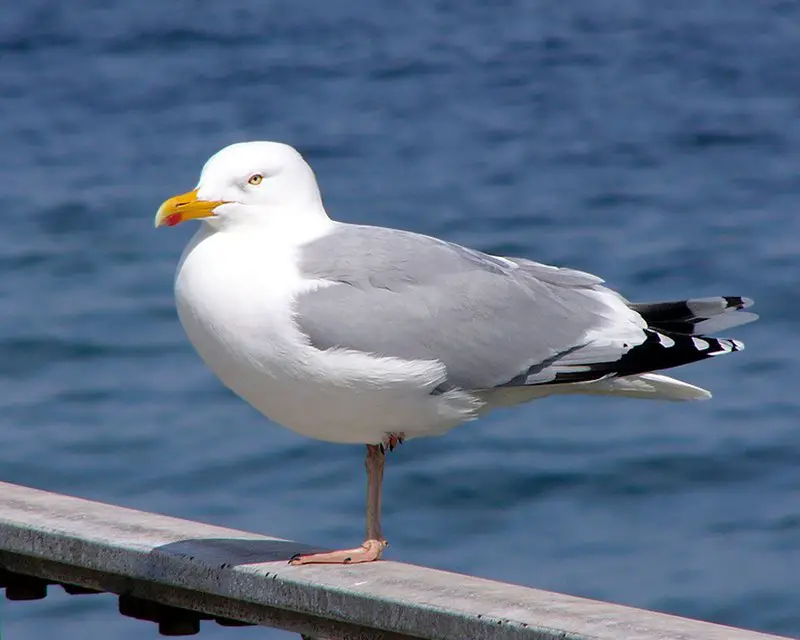
Gulls are a type of seabird in the family Laridae found worldwide. They are highly adaptable, often seen soaring above shorelines or near bodies of water.
Gulls have strong wings and long bills and vary greatly in size, colouration and behaviour from one species to another.
Some gull species feed on fish while others scavenge for food such as insects, small mammals or discarded human refuse.
Despite their different dietary habits they all share common traits including webbed feet which enable them to swim gracefully through the water after prey items like crabs or molluscs.
Gulls generally nest close to the shoreline where there is an abundance of available food sources making them excellent hunters that can live comfortably both on land and at sea.
Scientific classification:
| Kingdom | Animalia |
| Phylum | Chordata |
| Class | Aves |
| Order | Charadriiformes |
| Suborder | Lari |
| Family | Laridae Rafinesque, 1815 |
23. Sandwich Tern
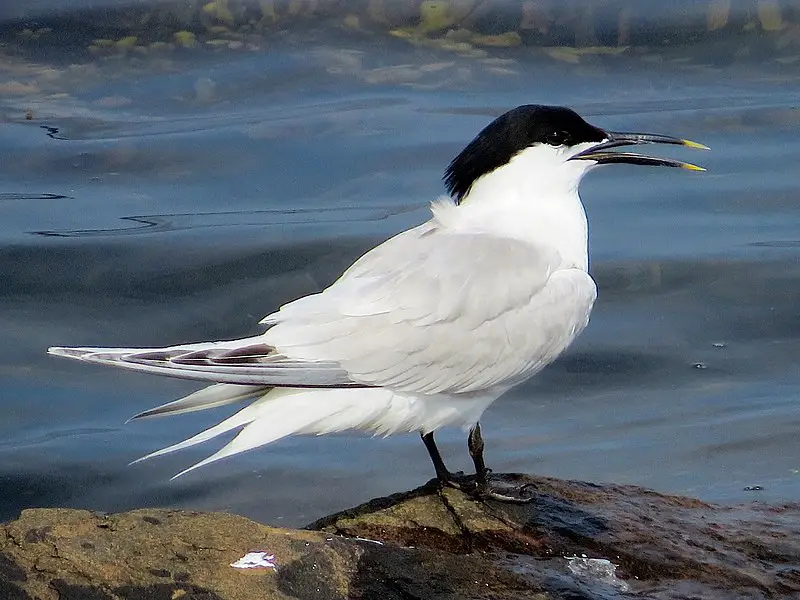
The Sandwich Tern is a medium-sized tern species belonging to the family Laridae. It has close relationships with four other crested terns, and is known to interbreed with the lesser crested.
These birds are distributed throughout Europe and as far east as Caspian Sea in summer, while they migrate south during winter season up to South Africa and India.
They have long wings which help them fly over vast distances effortlessly.
The plumage of these birds consists mainly of greyish tones on its body combined with white head and neck area; whereas it also sports an orange beak along black markings near their eyes – giving them a distinct look from other related species.
Scientific classification:
| Kingdom | Animalia |
| Phylum | Chordata |
| Class | Aves |
| Order | Charadriiformes |
| Family | Laridae |
| Genus | Thalasseus |
| Species | T. sandvicensis |
Also Featured In: Birds of Farne Islands, Common Birds of Portugal
24. Little Owl
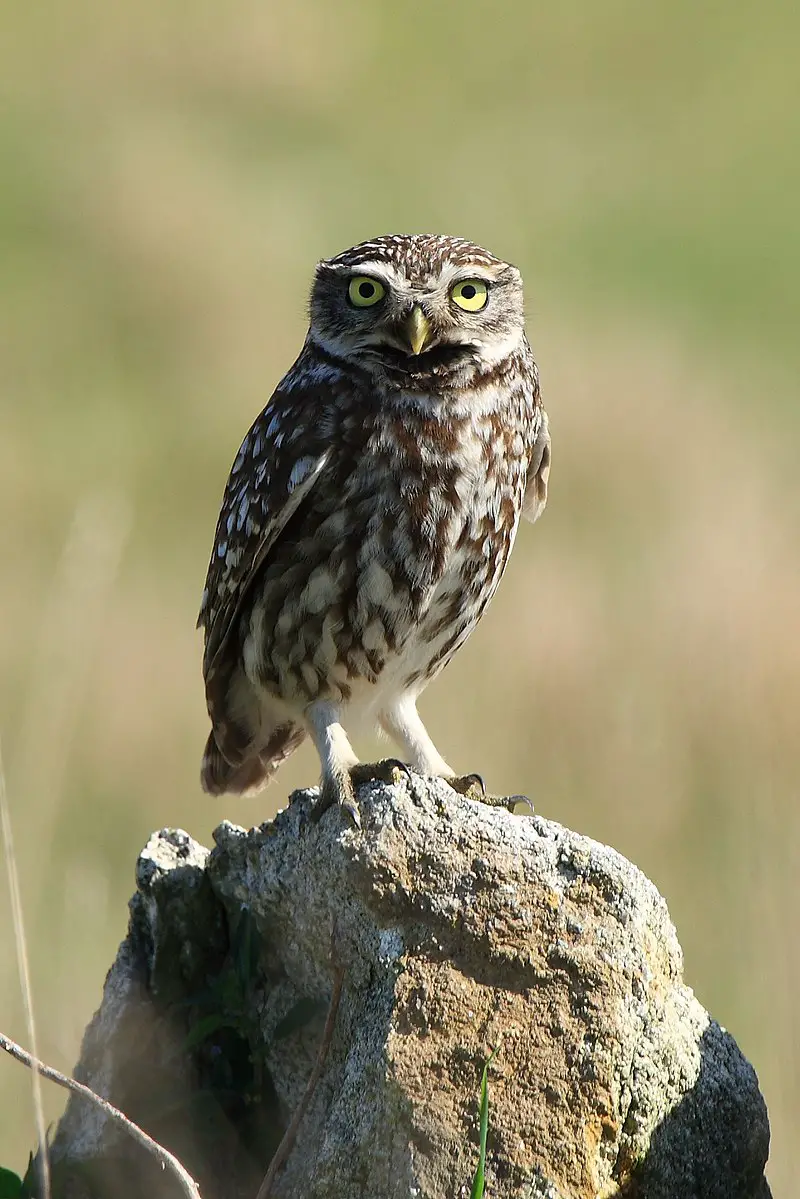
The Little Owl is a fascinating bird that inhabits much of the temperate and warmer parts of Europe, East Asia and North Africa. It’s also known as the “Owl of Athena” or “Owl of Minerva”.
This species was introduced to Britain in late 19th century and New Zealand’s South Island during early 20th century.
They belong to Strigidae family which are true owls with small bodies but large heads along with big eyes that helps them spot prey at night.
These birds feed on insects, earthworms, rodents like mice etc., making them beneficial for controlling pests around agricultural lands.
Besides these benefits they have become an important part in folklore associated with wisdom and knowledge over years due their silent presence near human dwellings after dark hours.
Scientific classification:
| Kingdom | Animalia |
| Phylum | Chordata |
| Class | Aves |
| Order | Strigiformes |
| Family | Strigidae |
| Genus | Athene |
| Species | A. noctua |
25. Black Grouse
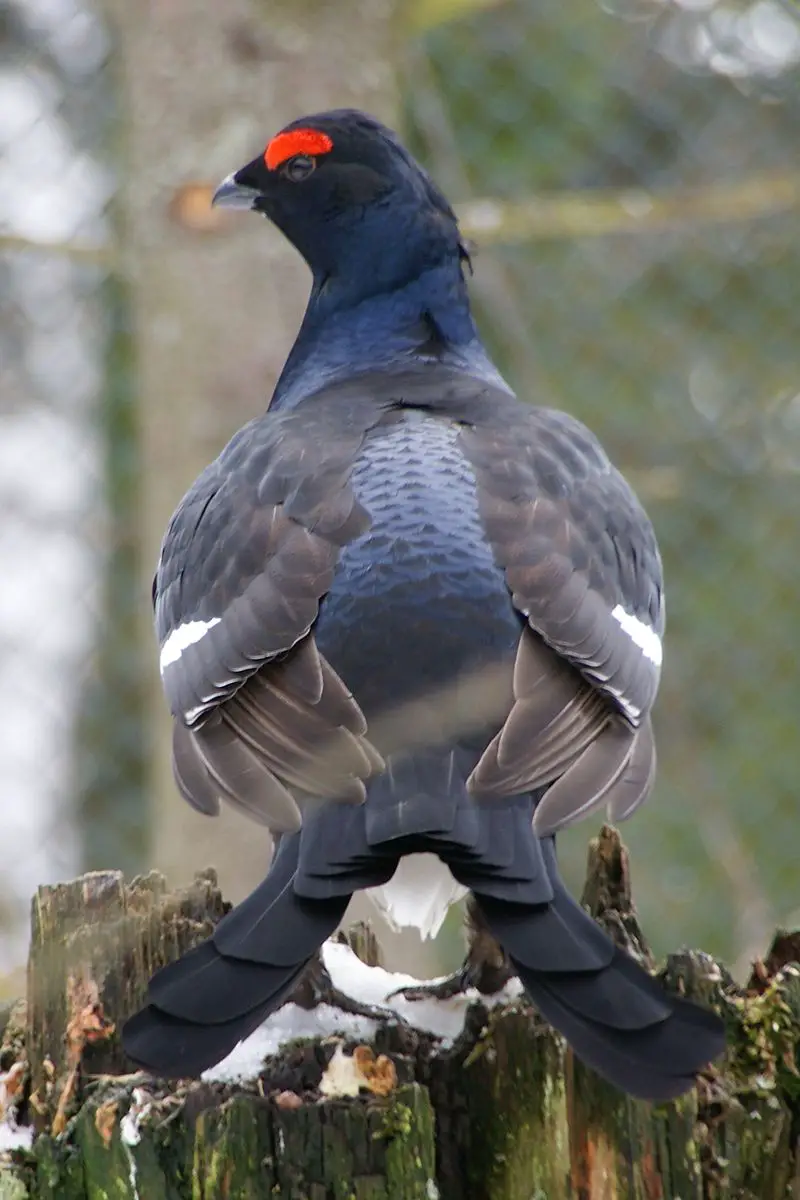
The black grouse is a large bird in the grouse family. It lives mainly in moorland and steppe habitats, often near wooded areas. In winter, it moves to dense forests where its diet consists almost exclusively of conifer needles.
These birds have an impressive wingspan of up to 75 cm wide, with males boasting dark metallic plumage and white tail feathers that they display during courtship rituals known as ‘leks’. Females are smaller than males with more brownish-grey coloured feathers.
Both sexes possess red combs above their eyes which become brighter during mating season – along with yellow wattles on their throats.
The black grouse is considered vulnerable due to loss of habitat caused by human activity such as deforestation and agricultural practices.
Scientific classification:
| Kingdom | Animalia |
| Phylum | Chordata |
| Class | Aves |
| Order | Galliformes |
| Family | Phasianidae |
| Genus | Lyrurus |
| Species | L. tetrix |
26. Eurasian Wryneck
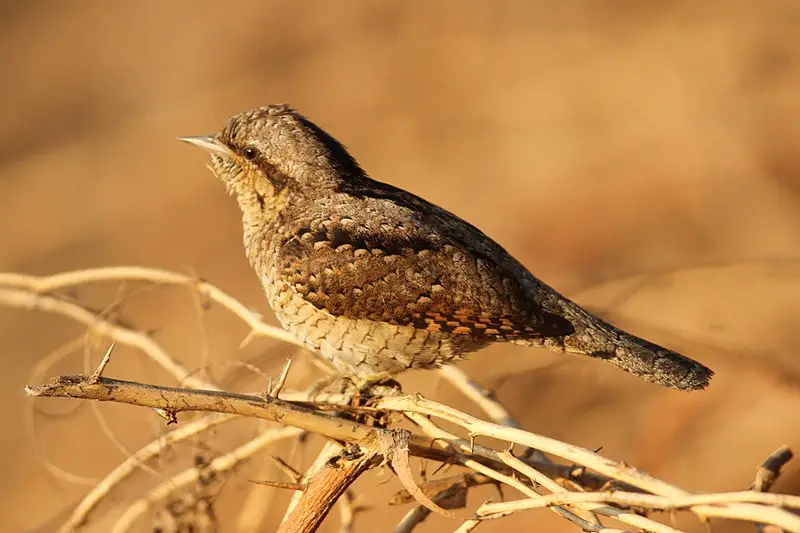
The Eurasian Wryneck is a species of woodpecker found in temperate regions of Europe and Asia. They breed during the summer months, but migrate south to tropical Africa or southern Asia for winter.
These birds are quite adaptable when it comes to their habitat, as they can be seen in open countryside, woodland, orchards and gardens alike.
To identify them you should look out for their distinctive brownish-grey feathers with black bars on the wings and tail; males also have red markings around their neck too.
Their diet consists mainly of insects which they find by probing into loose bark on trees or digging through soil with its sharp bill.
All in all an amazing bird that deserves more attention.
Scientific classification:
| Kingdom | Animalia |
| Phylum | Chordata |
| Class | Aves |
| Order | Piciformes |
| Family | Picidae |
| Genus | Jynx |
| Species | J. torquilla |
27. Dunlin

The Dunlin is a small wader, formerly known as part of the stint family. It has dull brown feathers and its name is derived from the dialect word “dunling”.
This bird breeds in Arctic or subarctic regions during summer months, but migrates to warmer climates during winter.
The Dunlin feeds on insects and invertebrates which it finds in mudflats and shallow waters.
During breeding season they form large flocks that can contain thousands of birds. They are also well-known for their impressive synchronized flight patterns that look like a wave moving through the sky.
Scientific classification:
| Kingdom | Animalia |
| Phylum | Chordata |
| Class | Aves |
| Order | Charadriiformes |
| Family | Scolopacidae |
| Genus | Calidris |
| Species | C. alpina |
28. Eurasian Curlew
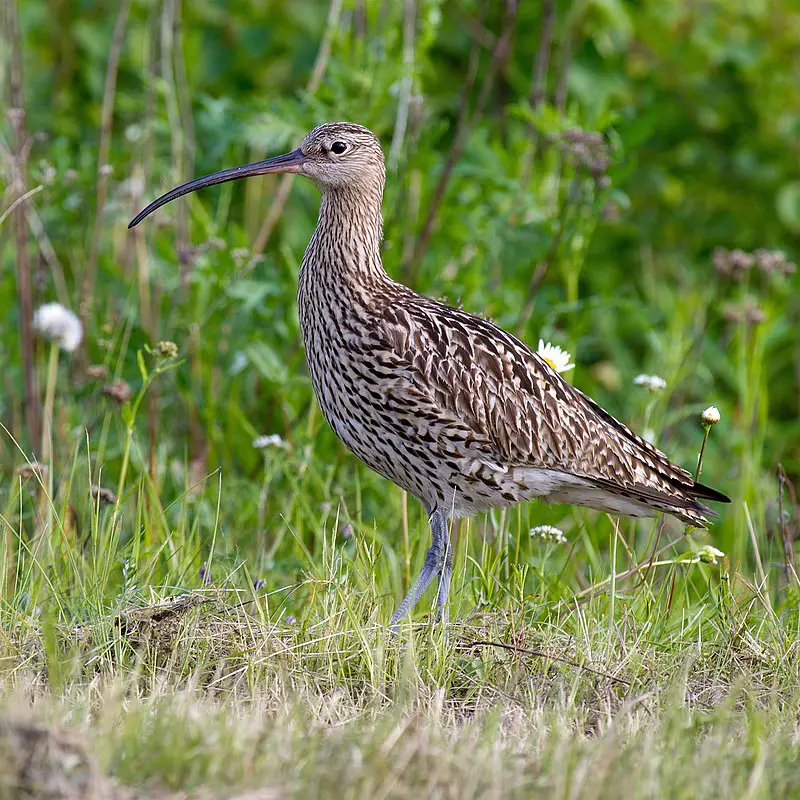
The Eurasian curlew is a wader bird belonging to the Scolopacidae family. It has an incredibly wide range, breeding across temperate Europe and Asia. This species can be easily identified by its long, curved bill and distinctive white underparts.
The male’s head typically appears striped while the female’s tends to be mottled brown in coloration with dark streaks on her neck and breast feathers.
With wingspans of almost two feet, these birds are quite large compared to other members of their genus.
Despite being so widespread they remain vulnerable due to ongoing habitat loss or degradation as well as hunting practices along migration routes or during wintering grounds visits.
Scientific classification:
| Kingdom | Animalia |
| Phylum | Chordata |
| Class | Aves |
| Order | Charadriiformes |
| Family | Scolopacidae |
| Genus | Numenius |
| Species | N. arquata |
29. Purple Sandpiper
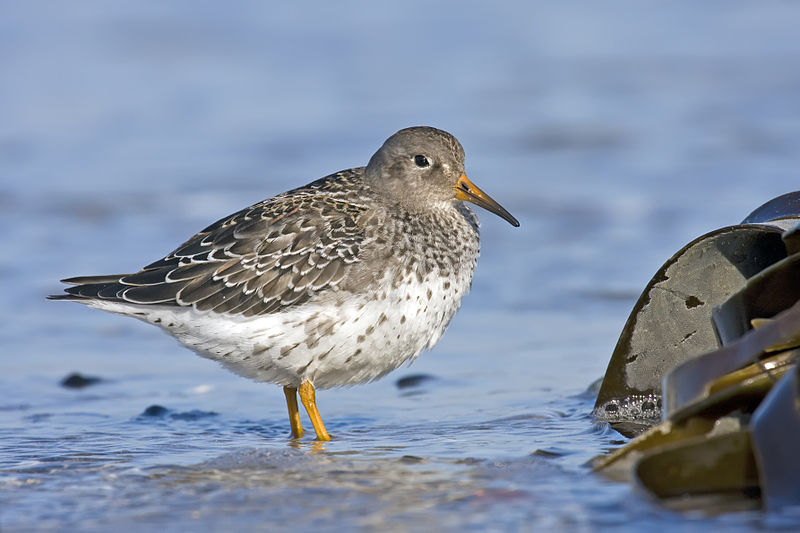
The Purple Sandpiper is a small shorebird of the Scolopacidae family, found in arctic and subarctic regions of Eurasia and North America. In winter it migrates south to the Atlantic coast for warmer temperatures.
It was formally described by Danish zoologist Morten Thrane Brünnich back in 1764 as Tringa maratina.
Generally grayish-brown with purple highlights on its head, neck and wings when seen from afar, this bird has white underparts that contrast beautifully against its darker feathers while standing out prominently against snow or ice covered landscapes during winters.
Its diet consists mainly of insects but also includes seeds, worms and other invertebrates which they search for along rocky shores or mudflats near ocean coasts throughout their range.
Scientific classification:
| Kingdom | Animalia |
| Phylum | Chordata |
| Class | Aves |
| Order | Charadriiformes |
| Family | Scolopacidae |
| Genus | Calidris |
| Species | C. maritima |
Also Featured In: Autumn Birds You Should Know, Birds that Live in Svalbard
30. Red Knot
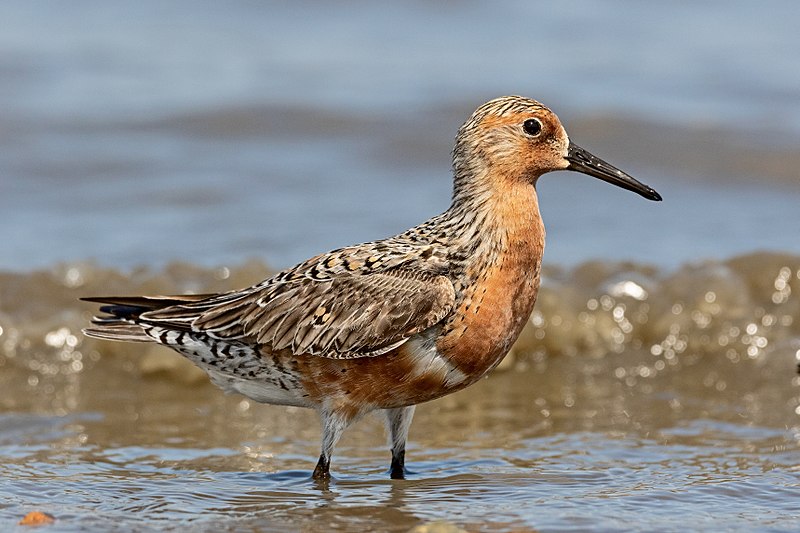
The Red Knot is a medium-sized shorebird that inhabits tundra and Arctic Cordillera in the far north of Canada, Europe and Russia.
It belongs to the Calidris sandpipers family, being one of its largest members second only to the Great Knot.
This species has six subspecies recognized worldwide. During breeding season their diet consists mainly on arthropods and larvae; however they may also feed on other items such as molluscs or crustaceans according to availability during migration periods.
They are known for their long migratory journeys which can last up to 20 000 kilometers per year – from wintering grounds in South America all the way through North American coasts until reaching summer nesting sites across Northern Eurasia.
Scientific classification:
| Kingdom | Animalia |
| Phylum | Chordata |
| Class | Aves |
| Order | Charadriiformes |
| Family | Scolopacidae |
| Genus | Calidris |
| Species | C. canutus |
Also Featured In: Flocks Birds around Us, Caribbean Birds
31. Little Tern
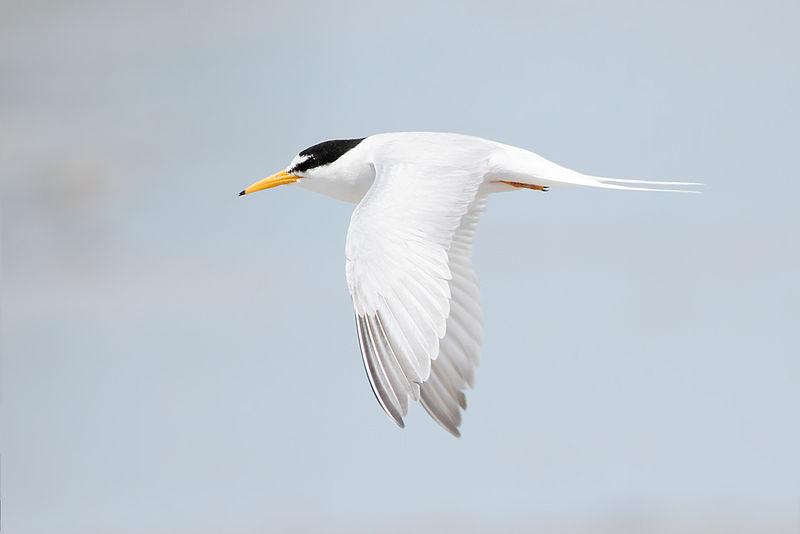
The Little Tern is a delightful seabird belonging to the Laridae family. It has white feathers, with a bright yellow bill and black legs. The species name ‘albifrons’ comes from Latin, meaning “white” and “forehead”.
Formerly they were placed in the genus Sterna which contains large white terns – hence their diminutive size. They can be found around coastal areas of Europe, North America (S.a antillarum) and Red Sea (S.a saundersi).
These birds are known for their graceful flight as they soar above both inland wetlands and marine waters looking for fish to feed on.
Their population numbers have been decreasing due to human impacts such as overfishing so we need to take care that these beautiful creatures continue thriving within our ecosystems.
Scientific classification:
| Kingdom | Animalia |
| Phylum | Chordata |
| Class | Aves |
| Order | Charadriiformes |
| Family | Laridae |
| Genus | Sternula |
| Species | S. albifrons |
Also Featured In: Birds of Norfolk, White Birds Commonly Found in Hawaii
32. Short-Eared Owl
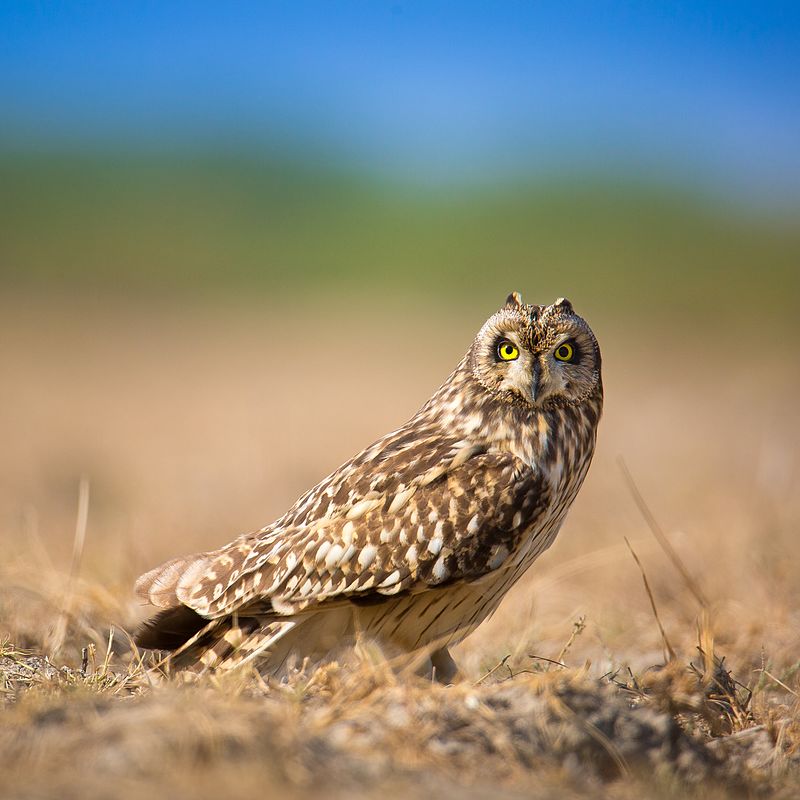
The Short-eared Owl is a species of owl belonging to the genus Asio, commonly known as ‘Eared Owls’. It has short tufts resembling mammalian ears that may or may not be visible.
When threatened they will display their tufts defensively; however these very short tufts are usually hard to spot.
This bird can be found in grassland habitats across much of the world and hunt mainly small mammals such as voles at night by swooping low over the ground from perches like trees and posts.
They also take other prey including birds, amphibians, reptiles and insects when available.
During breeding season males can often been seen performing aerial displays with claps of its wings while hovering above potential mates on territories it defends fiercely against intruders including humans.
Scientific classification:
| Kingdom | Animalia |
| Phylum | Chordata |
| Class | Aves |
| Order | Strigiformes |
| Family | Strigidae |
| Genus | Asio |
| Species | A. flammeus |
33. Long-Eared Owl
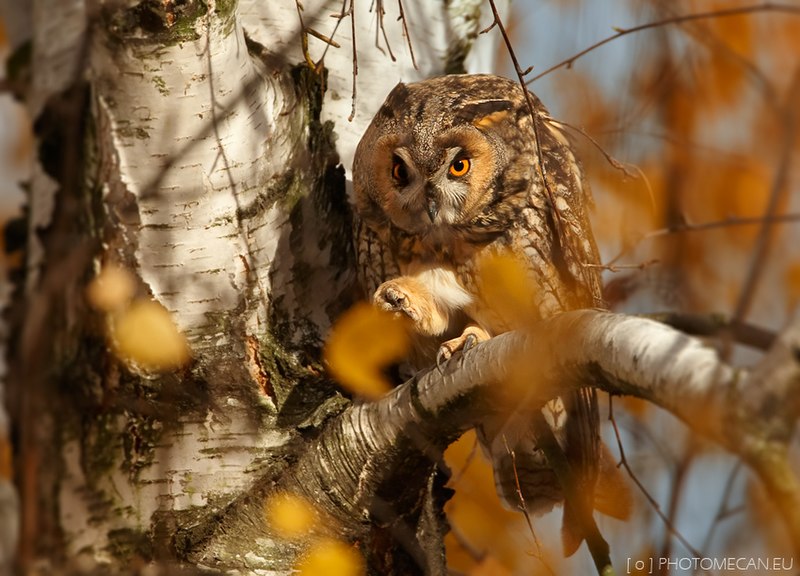
The Long-eared Owl is a medium sized species of owl with an extensive breeding range that spans across Europe and the Palearctic.
It has two distinct features, its long ears and yellow eyes, which can be seen during the day or at night due to their excellent vision.
Its diet consists mainly of small mammals such as voles and mice but it will also eat birds if given opportunity.
During winter months they may migrate south in search for food because there are less prey available in cold temperatures.
The Long-eared Owl prefers open habitats like meadows, fields or wetlands but sometimes uses forests too when hunting for food .
This makes them quite adaptable since they have no restrictions on where they choose to live.
Scientific classification:
| Kingdom | Animalia |
| Phylum | Chordata |
| Class | Aves |
| Order | Strigiformes |
| Family | Strigidae |
| Genus | Asio |
| Species | A. otus |
Also Featured In: Birds You’ll Find in Night, Birds of Taiga
34. Ruddy Turnstone
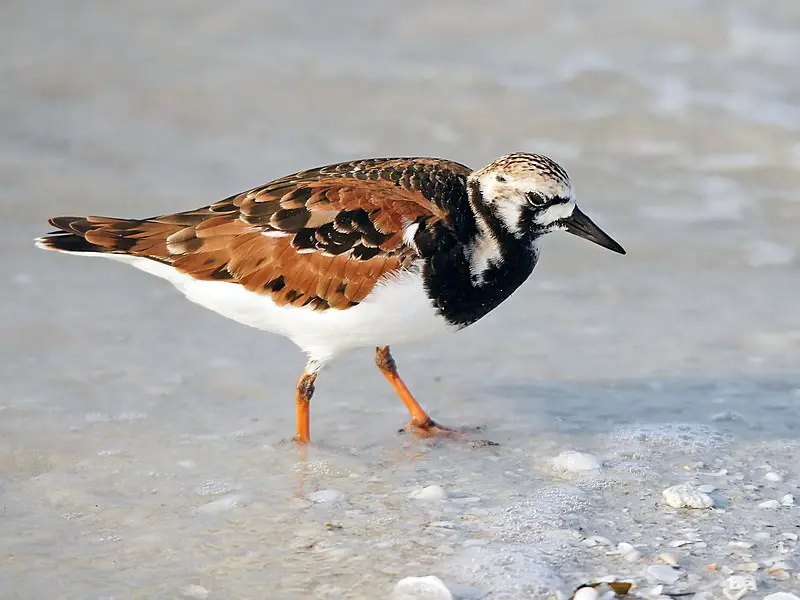
The Ruddy Turnstone is a small wading bird, belonging to the sandpiper family Scolopacidae. It has an attractive reddish-brown coloration and black patches on its back and wings.
This species breeds in northern parts of Eurasia and North America during summertime before migrating southwards in winter season to coastlines all over the world.
The Ruddy Turnstone feeds mainly on insects, mollusks, crustaceans, worms and some plant material such as seeds or berries which it finds by probing into mudflats with its bill.
It also uses stones for turning them when searching for food under rocks or pebbles along shorelines where they can often be seen darting around looking very busy.
Scientific classification:
| Kingdom | Animalia |
| Phylum | Chordata |
| Class | Aves |
| Order | Charadriiformes |
| Family | Scolopacidae |
| Genus | Arenaria |
| Species | A. interpres |
Also Featured In: Galapagos Birds You Should Know, Hawaii Big Island Birds You Should Know
35. Common Wood Pigeon
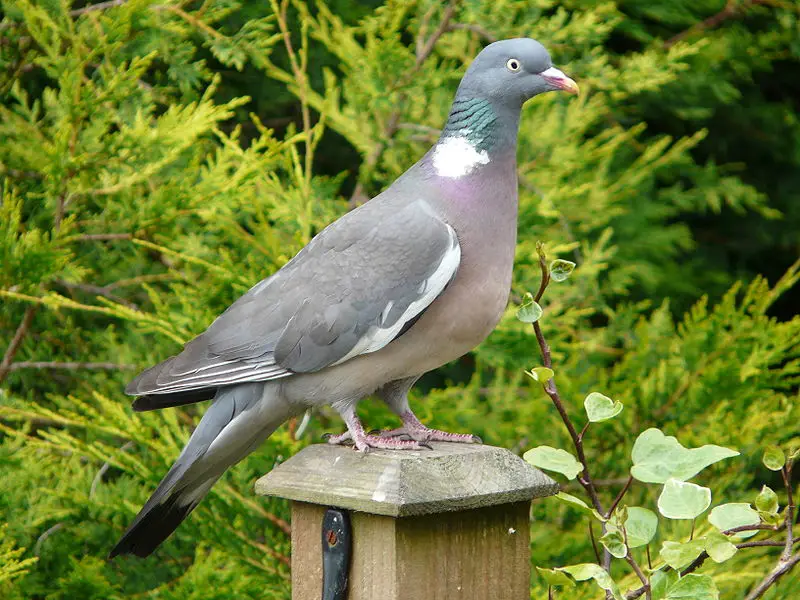
The Common Wood Pigeon is a large bird of the dove and pigeon family, native to the western Palearctic. It has grey plumage with white patches on its wings and neck.
Its head often appears darker than its body due to iridescence in some parts of its feathers. The male woodpigeons have pinkish breasts while females are more brownish-grey coloured.
These birds feed mainly on seeds, fruits, flowers and leaves but will also eat insects when available.
They breed during springtime producing 1-2 clutches per breeding season with two eggs each time which hatch after about 18 days incubation period by both parents taking turns for duty.
They make their nests from twigs collected from nearby trees or places close by and usually raise only one brood at a time making them an important part of nature’s balance as they help keep insect populations under control through their diet choices.
Scientific classification:
| Kingdom | Animalia |
| Phylum | Chordata |
| Class | Aves |
| Order | Columbiformes |
| Family | Columbidae |
| Genus | Columba |
| Species | C. palumbus |
36. New World Warblers
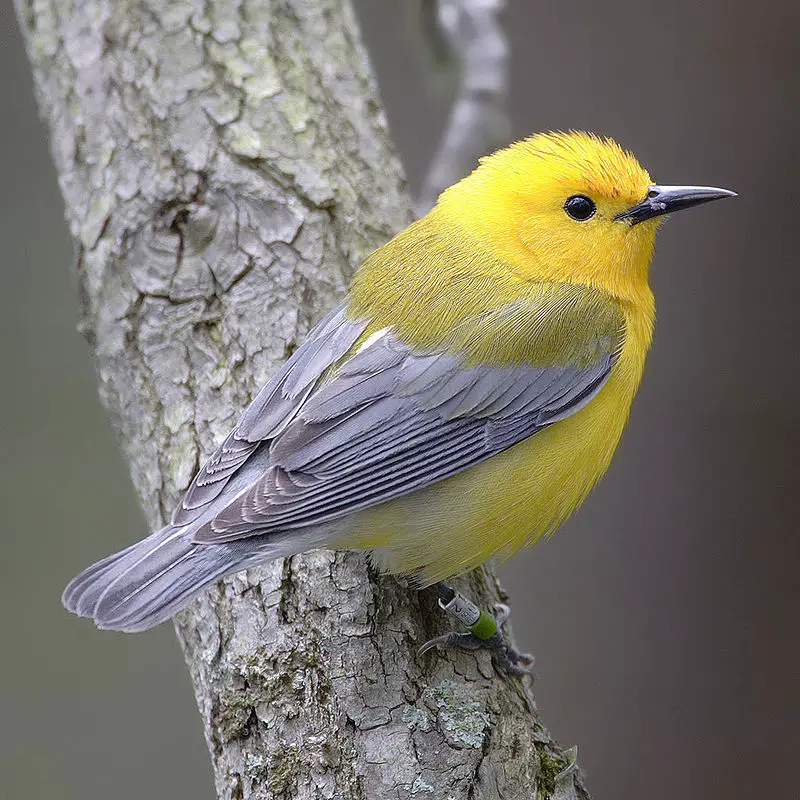
New World warblers are an incredibly diverse family of small birds found only in the Americas. They range in size from tiny hummingbirds to large thrushes, and come in a variety of vibrant colors.
All have thin bills made for eating insects which form their main diet. Most species live predominantly arboreal lives, meaning they spend most of their time among trees or bushes searching for food.
However some members such as ovenbirds and waterthrushes prefer more terrestrial habitats like forest floors where they can scavenge for bugs on the ground instead.
Warblers provide a great source of entertainment with their beautiful songs often filling up woodlands during mornings and evenings throughout springtime.
Scientific classification:
| Kingdom | Animalia |
| Phylum | Chordata |
| Class | Aves |
| Order | Passeriformes |
| Superfamily | Emberizoidea |
| Family | Parulidae Wetmore et al., 1947 |
37. Lesser Spotted Woodpecker
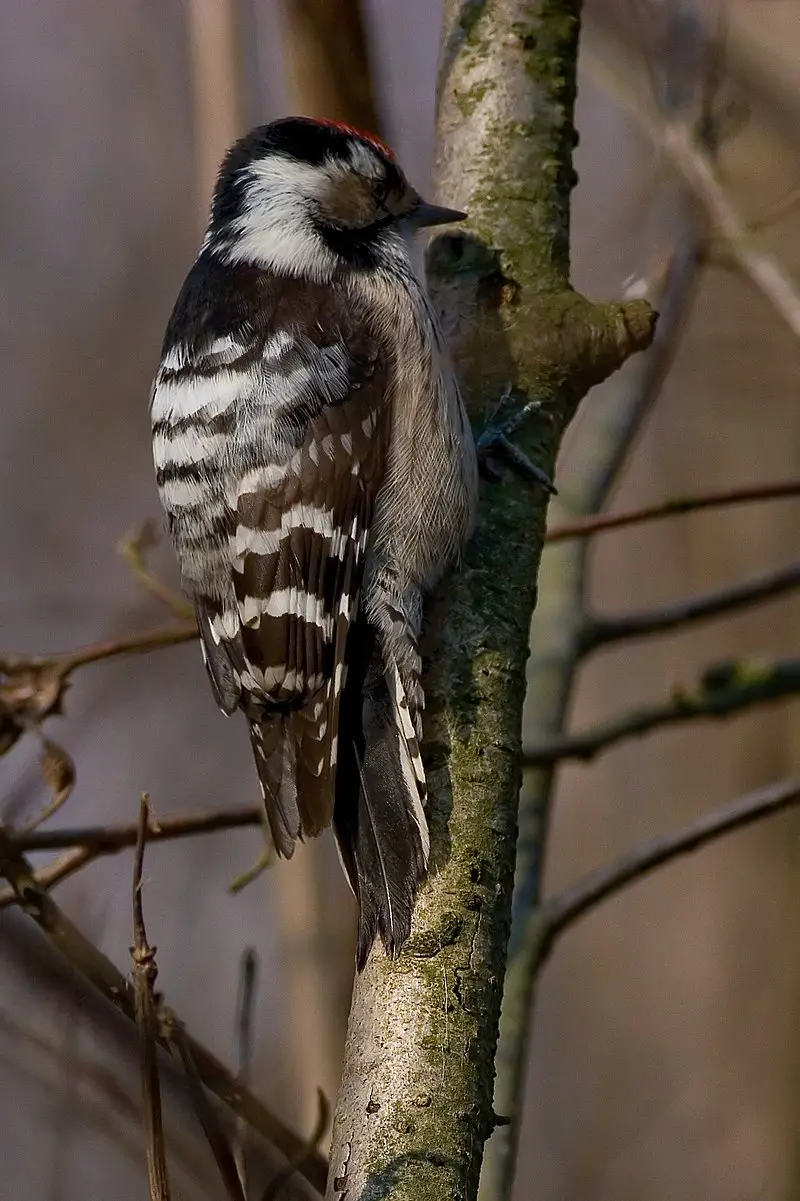
The Lesser Spotted Woodpecker (Dryobates minor) is a small, attractive bird belonging to the woodpecker family Picidae.
It is found in much of Europe and parts of Asia.
The species was previously classified under the genus Dendrocopos but has now been reassigned to Dryobates.
This beautiful little bird is characterized by its brown body with black wings, tail and head.
Its belly and throat are white while there are red patches on both sides of its neck-collar region. In addition, it also possesses yellowish stripes near its eyes that make it look quite smart.
The lesser spotted woodpeckers feed mainly on insects such as ants and beetles which they find beneath tree bark or among dead leaves.
They can be seen foraging alone or in pairs since they prefer living an isolated life away from human settlements.
Thus if you ever wish to spot one remember not to disturb them during their search for food else you might miss out this amazing opportunity.
Scientific classification:
| Kingdom | Animalia |
| Phylum | Chordata |
| Class | Aves |
| Order | Piciformes |
| Family | Picidae |
| Genus | Dryobates |
| Species | D. minor |
38. Eurasian Jay
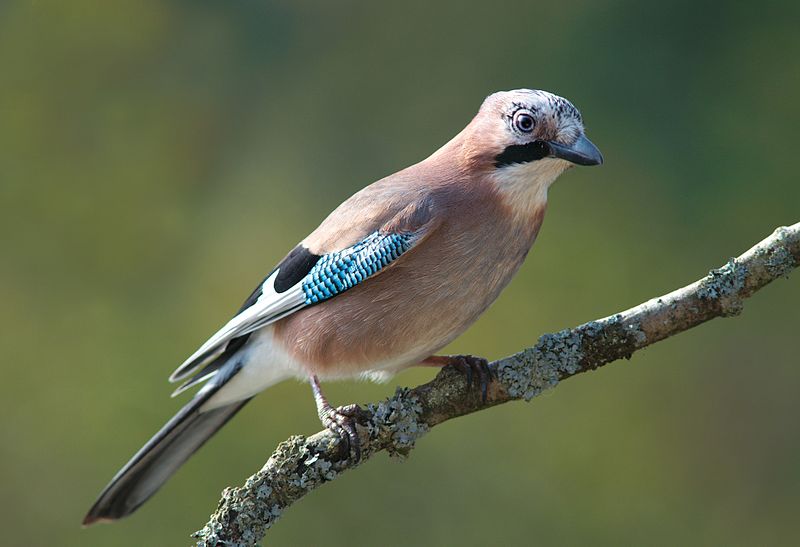
The Eurasian jay is a beautiful passerine bird of the crow family, Corvidae. It has bright pinkish brown plumage with white throat and two black stripes on each side.
The upper wings have an eye-catching blue panel while its tail is all black in color. This species mainly resides in woodlands, spanning over vast regions from western Europe to India and even north-west Africa.
Its diet consists of small invertebrates like insects as well as fruits, seeds and nuts making it quite adaptable when it comes to food sources.
With its loud calls echoing through the forests they inhabit, this amazing creature will definitely make your day brighter if you ever get the chance to spot one.
Scientific classification:
| Kingdom | Animalia |
| Phylum | Chordata |
| Class | Aves |
| Order | Passeriformes |
| Family | Corvidae |
| Genus | Garrulus |
| Species | G. glandarius |
39. Stone-Curlew

Stone-curlews, also known as dikkops or thick-knees, are a family of birds that have adapted to live in tropical and temperate regions throughout the world.
They can be found in Africa, Asia and Australia with two or more species per region. Despite being classified as waders, most prefer dry arid habitats over moist wetlands.
Stone-curlews typically have long legs which help them navigate through their preferred terrain efficiently; some species even stand at an impressive height when standing on those long legs.
Additionally they feature cryptic plumage which helps them blend into their surroundings while hunting for prey such as insects and small mammals like rodents.
These unique bird’s calls are easily recognizable; it has been said that hearing one is similar to listening to someone whistling ‘Keee Weee’.
Scientific classification:
| Kingdom | Animalia |
| Phylum | Chordata |
| Class | Aves |
| Order | Charadriiformes |
| Suborder | Chionidi |
| Family | Burhinidae Mathews, 1912 |
40. Cardinal
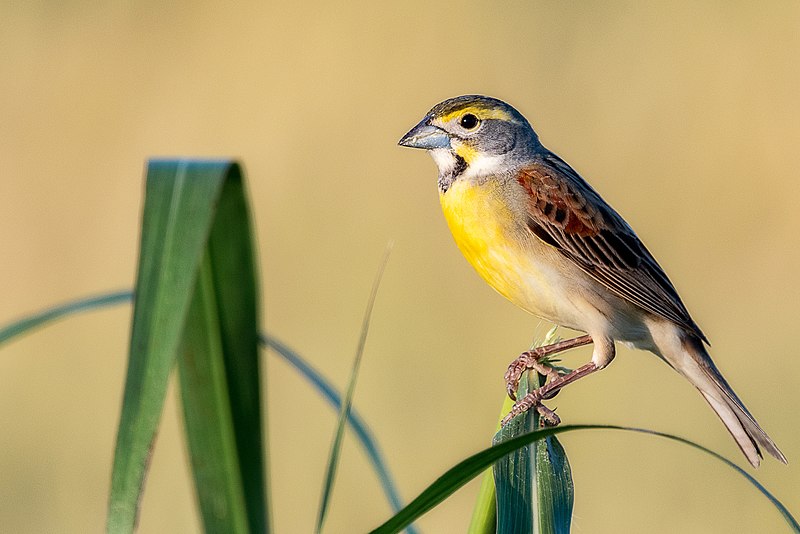
Cardinalidae is a family of passerine birds endemic to the New World that includes cardinals, grosbeaks and buntings.
This large group has great diversity in its members which range from tanager-like Piranga to warbler-like Granatellus.
They are usually distinguished by their bright plumage with reds, oranges and yellows being common among them.
Their strong bills enable them to feed on seeds, fruits and insects as well as other small prey items like lizards or frogs depending upon species.
Cardinals also have loud calls often used for territorial defense and courtship purposes while some can even imitate sounds made by other animals.
These adaptable birds inhabit a variety of habitats across North America making them an important part of many ecosystems there.
Scientific classification:
| Kingdom | Animalia |
| Phylum | Chordata |
| Class | Aves |
| Order | Passeriformes |
| Superfamily | Emberizoidea |
| Family | Cardinalidae Ridgway, 1901 |
41. Plovers

Plovers are a family of around 64-68 species of ground-dwelling birds, commonly found in open country such as fields, meadows and tundras.
They have short bills with webbed feet to help them forage through mud or shallow water.
Plover plumage is usually mottled brown though some species may have brighter colors on the head and wings.
These birds feed mainly on insects but can also eat small crustaceans and worms.
Plovers breed during springtime when they dig holes in sandy or pebbled beaches to lay their eggs which hatch after about 3 weeks incubation period.
They use distraction display behaviour by pretending an injury to the predators away from their nests if needed for protecting their young ones.
Scientific classification:
| Kingdom | Animalia |
| Phylum | Chordata |
| Class | Aves |
| Order | Charadriiformes |
| Family | Charadriidae Leach, 1820 |
42. Stilts And Avocets
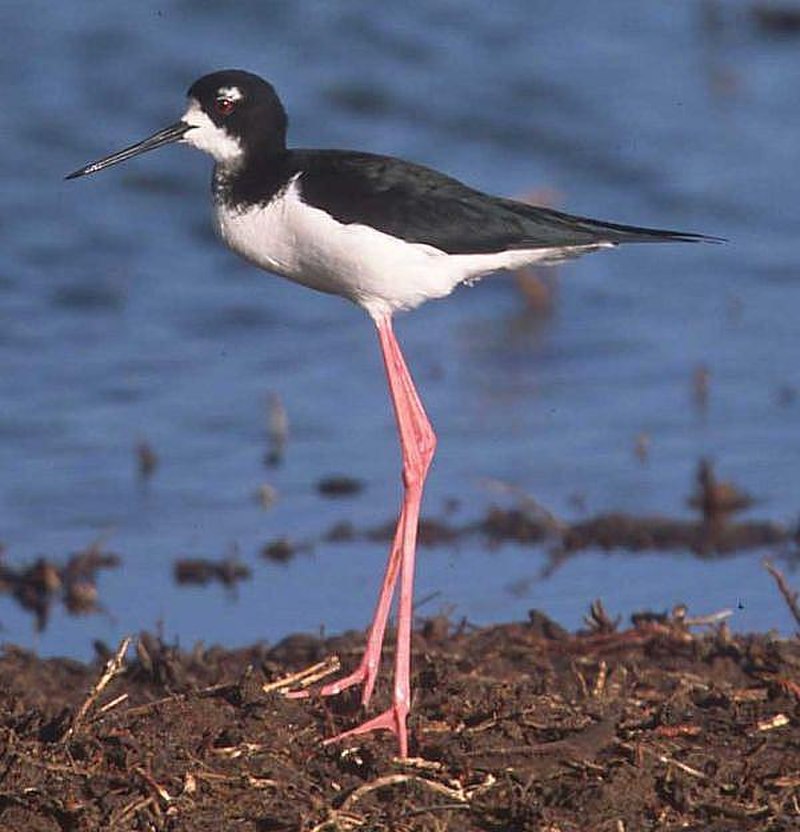
Stilts and avocets are two distinct groups of birds belonging to the family Recurvirostridae. They range in length from 30-46 cm (12-18 inches) and weigh between 140 – 435 g (4.9 – 15.3 ounces).
Males usually have slightly larger bodies than females, with long thin legs, necks and bills.
Avocet bills curve upwards uniquely while stilt beaks remain straight most times.
These wading birds live mainly near shorelines or wetlands where they feed on aquatic invertebrates like brine shrimp, insects etc., occasionally supplementing their diet with seeds or small fish too.
Stilts also inhabit open fields in search of food sources such as earthworms or grasshoppers during the non-breeding season.
Both groups migrate over large distances for warmer weathers when it gets cold outside.
Scientific classification:
| Kingdom | Animalia |
| Phylum | Chordata |
| Class | Aves |
| Order | Charadriiformes |
| Suborder | Charadrii |
| Family | Recurvirostridae Bonaparte, 1854 |
43. Common Kingfisher
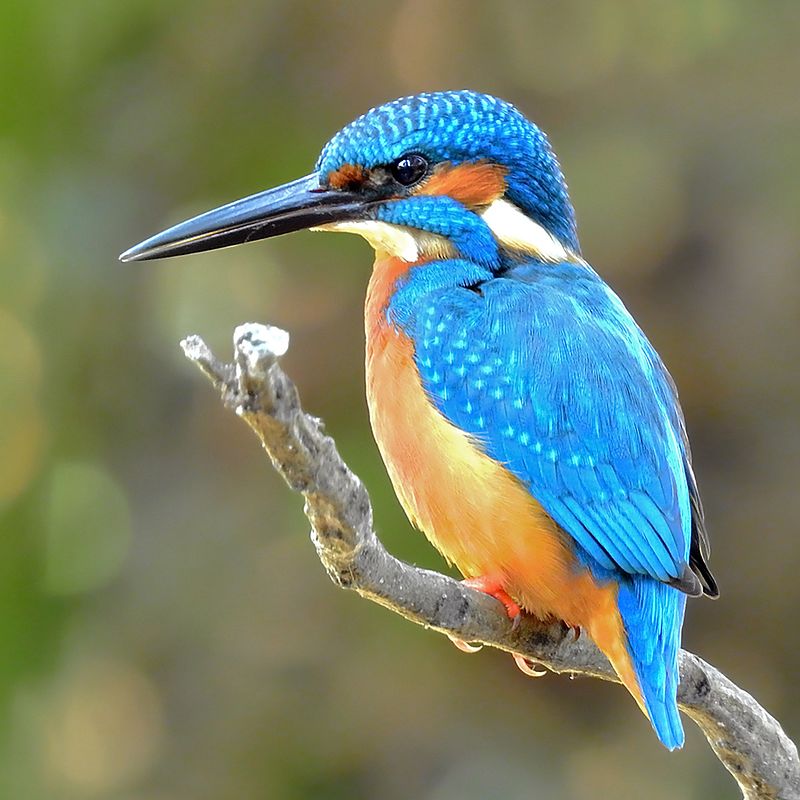
The Common Kingfisher is a small, sparrow-sized bird that can be found across Eurasia and North Africa. It has the typical short tail and large head of kingfishers with seven different subspecies recognized in its range.
They are mainly resident birds but will migrate away during winter when rivers freeze over. The species usually live near bodies of water such as streams or lakes.
Where they hunt for fish by diving from above into the water after spotting their prey below them.
These brightly coloured birds have an unmistakable vibrant blue plumage along with orange underparts and white patches on their wings which makes them easy to recognize amongst other similar looking species.
Their call is loud and shrill making it one of the most recognizable sounds heard around wetlands throughout Europe.
Scientific classification:
| Kingdom | Animalia |
| Phylum | Chordata |
| Class | Aves |
| Order | Coraciiformes |
| Family | Alcedinidae |
| Subfamily | Alcedininae |
| Genus | Alcedo |
| Species | A. atthis |
44. Larks
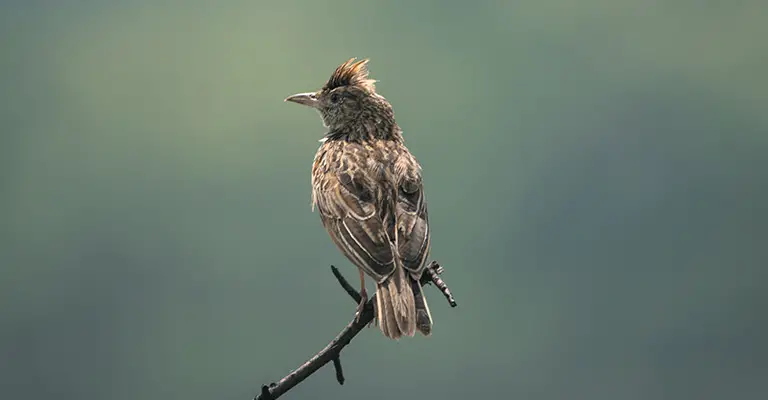
Larks are small passerine birds that belong to the Alaudidae family. These birds have a cosmopolitan distribution and can be found in many different habitats, including dry regions.
The largest number of lark species is located in Africa, while only one species (horned lark) inhabits North America and another one (Horsfield’s bush lark) lives in Australia.
These beautiful creatures usually appear during dawn or dusk as they sing their melodious songs high up into the sky.
Larks possess impressive flying skills which make them capable of reaching heights far above most other bird species.
Despite this skill, they prefer living close to the ground where there are plenty of seeds and insects for them to feed on.
Scientific classification:
| Kingdom | Animalia |
| Phylum | Chordata |
| Class | Aves |
| Order | Passeriformes |
| Superfamily | Sylvioidea |
| Family | Alaudidae Vigors, 1825 |
45. Bearded Reedling
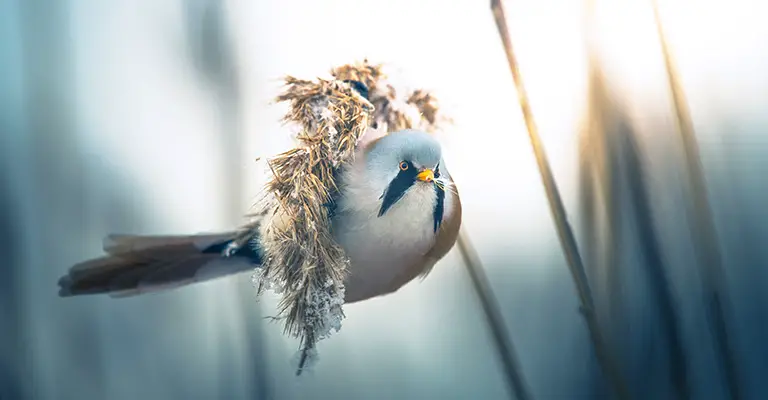
The Bearded Reedling is a small passerine bird found in reed-beds across Europe, Asia and North Africa.
It is easily identified by its distinct black and white plumage with males having yellow faces.
This species belongs to the only family of birds known as Panuridae and was first described by Carl Linnaeus back in 1758.
They feed on insects such as beetles, flies, moths among others but also consume seeds from plants like sedges or rushes during winter months when food availability decreases significantly.
These birds are territorial meaning that they have their own area where they live which can vary from 8 to 12 hectares depending on the seasonality of insect abundance within these areas making them an important part for maintaining healthy ecosystems in wetlands around their range.
Scientific classification:
| Kingdom | Animalia |
| Phylum | Chordata |
| Class | Aves |
| Order | Passeriformes |
| Family | Panuridae Des Murs, 1860 |
| Genus | Panurus Koch, 1816 |
| Species | P. biarmicus |
46. Eurasian Penduline Tit
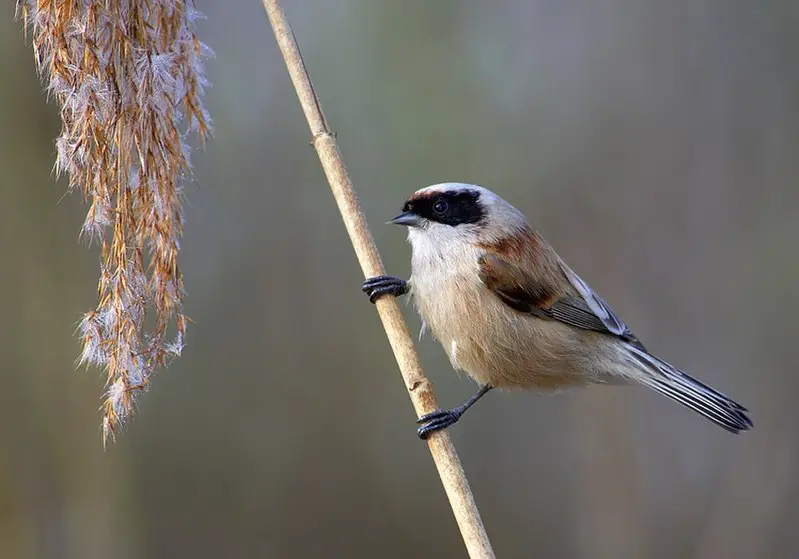
The Eurasian penduline tit is a passerine bird of the genus Remiz which can be found widely across the western Palearctic.
It migrates to more northern parts in summer, while staying resident in its southern range during winter months.
This species experienced an expansion of its breeding grounds throughout Western Europe between 1980s and 1990s, thus increasing its population significantly.
The Penduline Tit has various striking features like bright yellow underparts with black streaks on sides.
Greyish-brown upper part with white underside and pale eye line along head sides as well as distinctive tail nest made from fibers and mosses hanging from trees or shrubs like a pendulum hence their name ‘Penduline’.
These birds feed mainly on insects but also eat some seeds especially sunflower seeds making them popular garden visitors for many people.
Scientific classification:
| Kingdom | Animalia |
| Phylum | Chordata |
| Class | Aves |
| Order | Passeriformes |
| Family | Remizidae |
| Genus | Remiz |
| Species | R. pendulinus |
47. Grey Plover
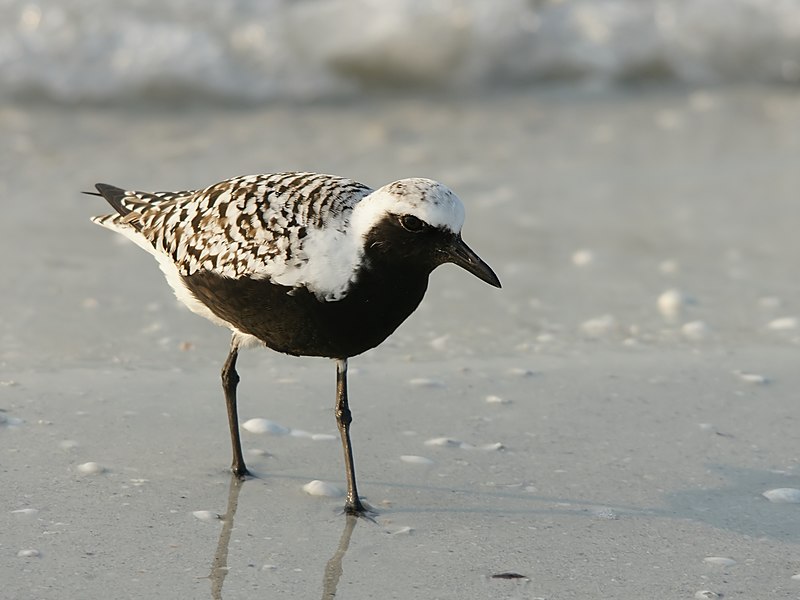
The Grey Plover is a large plover bird which breeds in the Arctic regions. It then migrates over long distances, and can be found on coastlines around the world when not breeding.
The species was first described by Swedish naturalist Carl Linnaeus in 1758 under its binomial name “Tringa squatarola”.
In addition to being known as grey plovers or black-bellied plovers, they are also sometimes referred to as “black-breasted lapwings” due to their distinctive plumage that features white underneath with dark greys above.
These birds inhabit beaches, mudflats and saltmarshes where they feed mainly on small invertebrates such as worms and insects.
Scientific classification:
| Kingdom | Animalia |
| Phylum | Chordata |
| Class | Aves |
| Order | Charadriiformes |
| Family | Charadriidae |
| Genus | Pluvialis |
| Species | P. squatarola |
Also Featured In: Birds that can be Seen in Outer Banks, Tundra Birds
48. Black-Legged Kittiwake
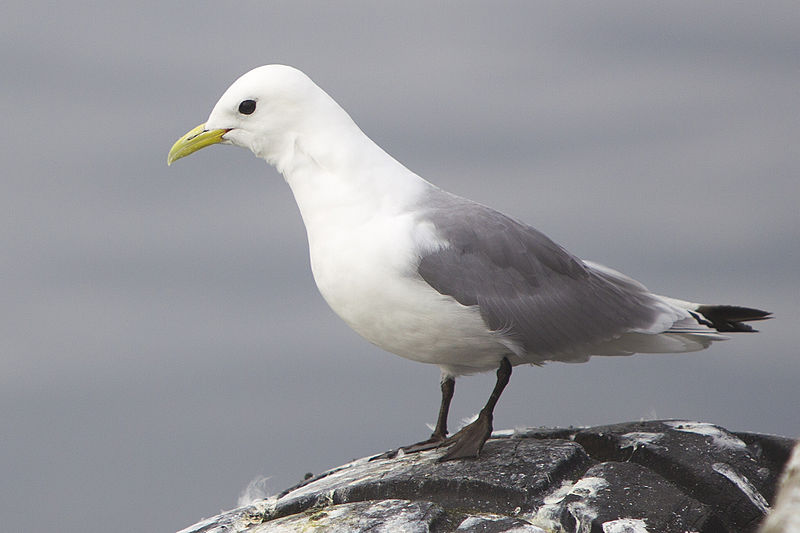
The Black-legged Kittiwake is a seabird of the gull family Laridae. It was first described by Carl Linnaeus in 1758 and its name derives from its distinctive call which sounds like ‘kittee-wa-aaake, kitte-wa-aaake’.
These birds are mainly found along coastal regions with plenty of food sources such as plankton and fish. They have white bodies with slate grey wings and black legs.
The bill is yellowish orange to red depending on age or season.
In winter they migrate southwards away from their northern habitats into warmer waters for breeding purposes before returning again once spring arrives.
Scientific classification:
| Kingdom | Animalia |
| Phylum | Chordata |
| Class | Aves |
| Order | Charadriiformes |
| Family | Laridae |
| Genus | Rissa |
| Species | R. tridactyla |
Also Featured In: Birds You’ll Find in the Sea, Common Cornwall Birds
49. Arctic Tern
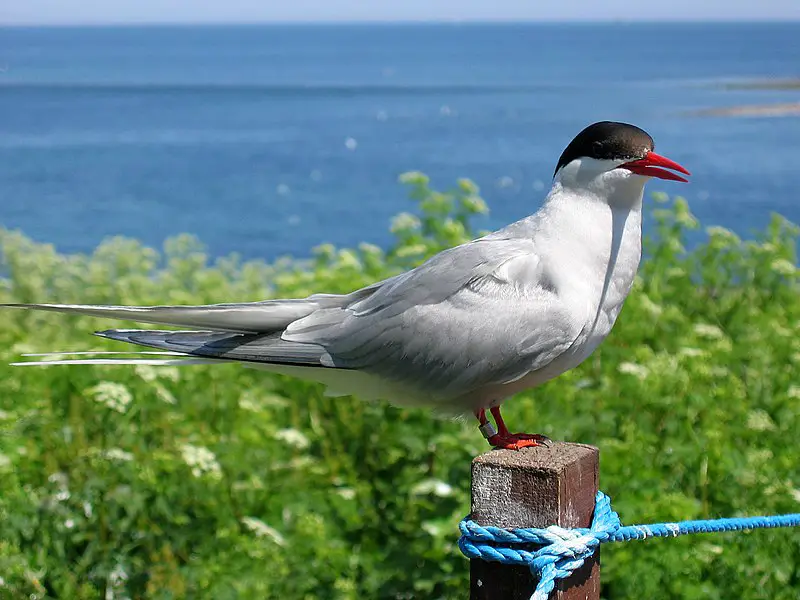
The Arctic tern is an incredible bird that displays a truly remarkable migratory behavior.
It breeds in the northern regions of Europe, Asia and North America during summer before undertaking its migration along a convoluted route to reach the Antarctic for winter.
This species has adapted extremely well to its environment – it can fly very long distances while navigating with ease thanks to their excellent eyesight.
Furthermore, they are able to survive in temperatures as low as -40 degrees Celsius.
The Arctic Tern is also known for being one of the longest living birds on Earth; some have been recorded living up to 30 years old.
Scientific classification:
| Kingdom | Animalia |
| Phylum | Chordata |
| Class | Aves |
| Order | Charadriiformes |
| Family | Laridae |
| Genus | Sterna |
| Species | S. paradisaea |
50. Coots
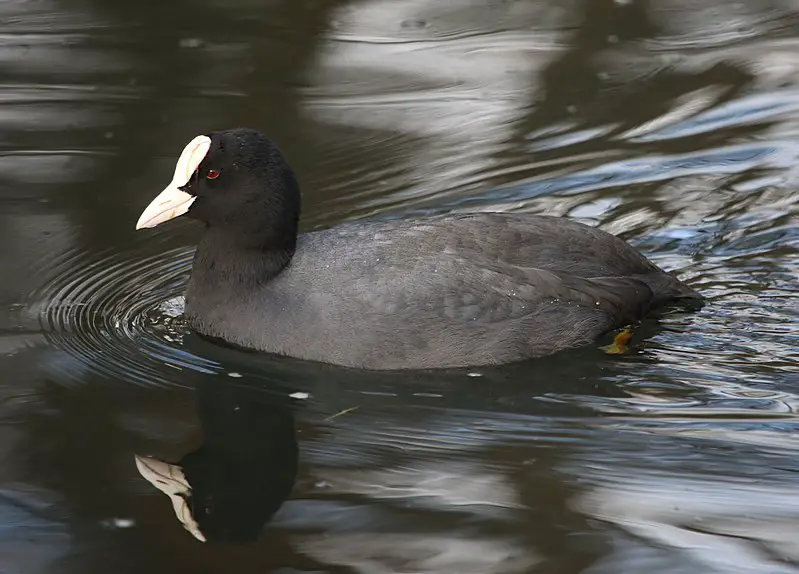
Coots are members of the rail family, Rallidae. They have black plumage and can often be seen swimming in open water.
Quite distinct from their close relatives – moorhens – coots appear dumpier and lack a red frontal shield on their forehead.
These birds reach an average length between 11 to 17 inches with wingspans ranging from 20-27 inches wide; they weigh up to 2 pounds when fully grown.
Coots feed mainly on plant material such as seeds, buds, fruits and leaves but will also eat small aquatic invertebrates like crustaceans or insects if available.
The nest is built by both parents using vegetation that has been collected at the edge of wetlands or ponds.
Which makes it difficult for predators to access them easily making them better protected than other species of bird nests found near water sources.
Scientific classification:
| Kingdom | Animalia |
| Phylum | Chordata |
| Class | Aves |
| Order | Gruiformes |
| Family | Rallidae |
| Genus | Fulica Linnaeus, 1758 |